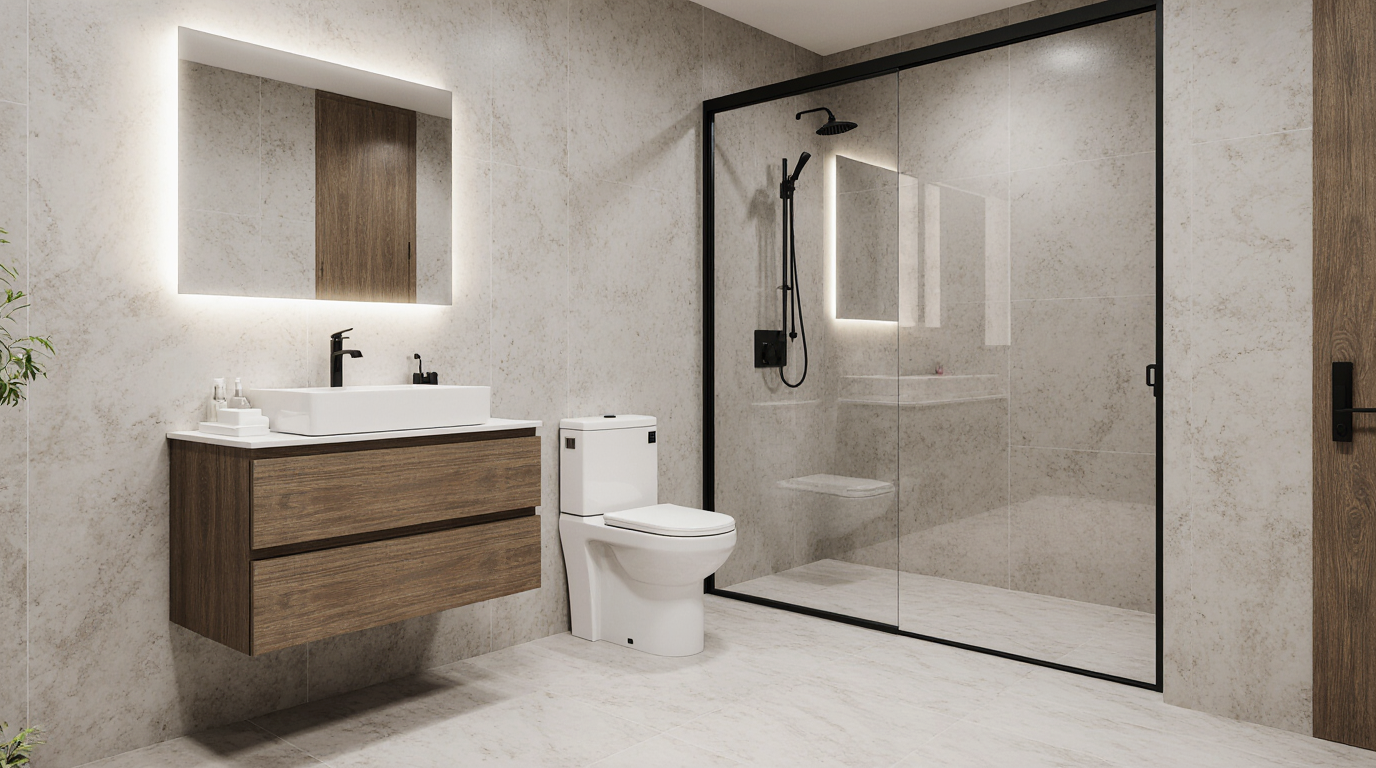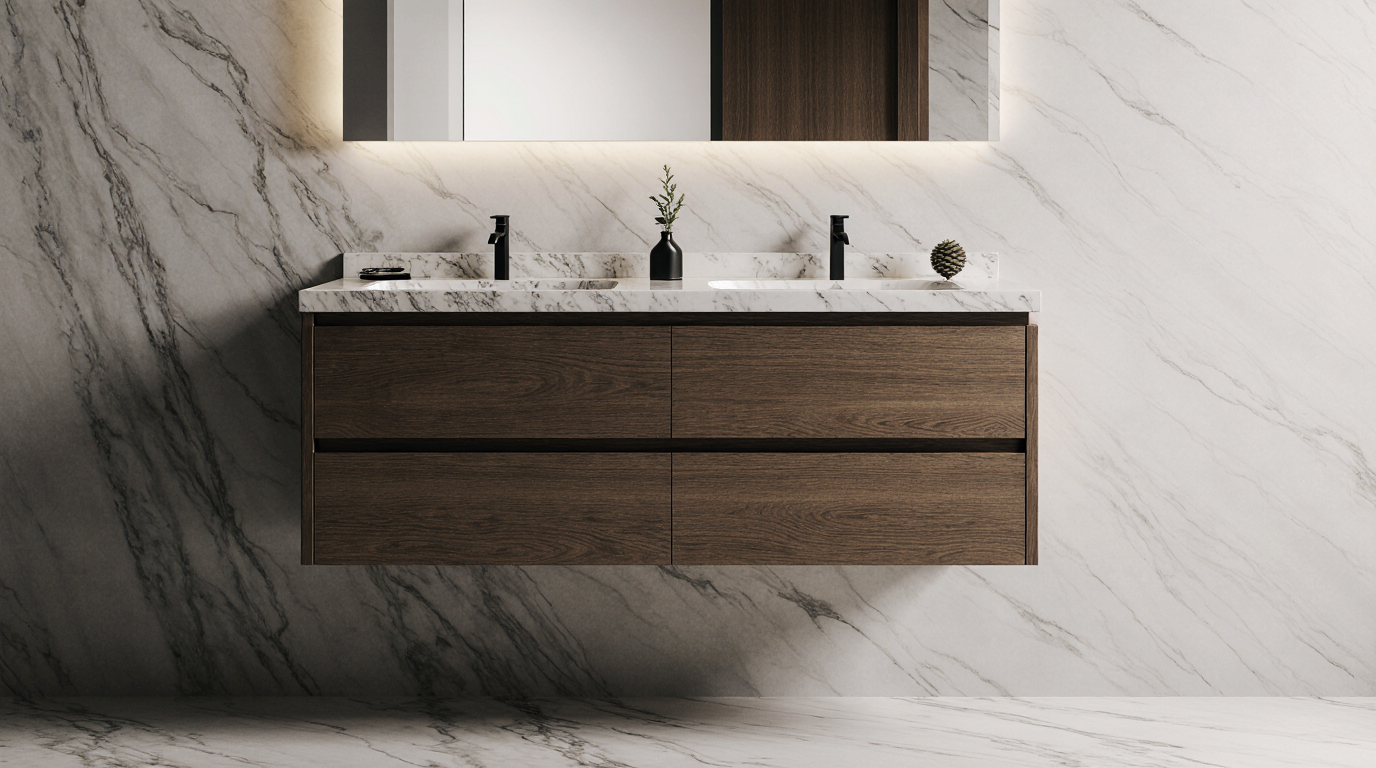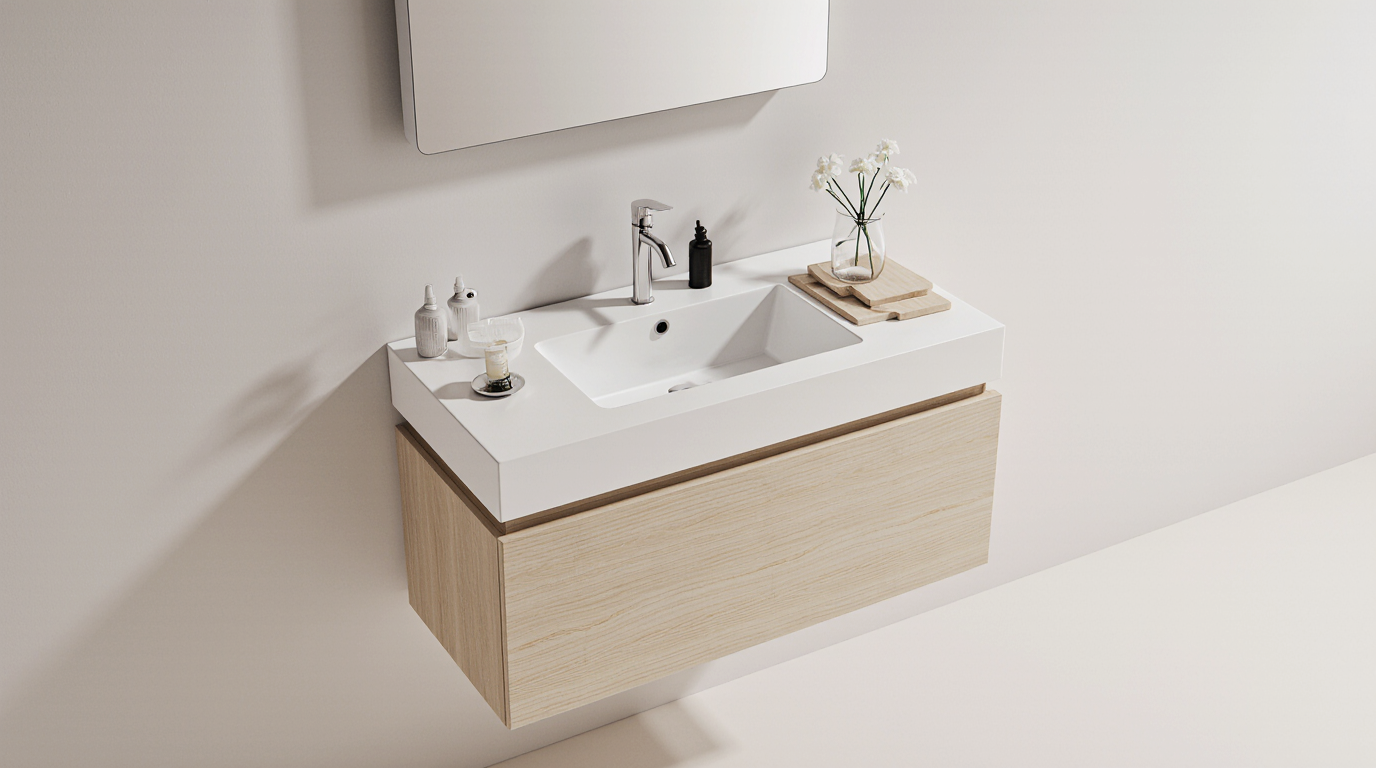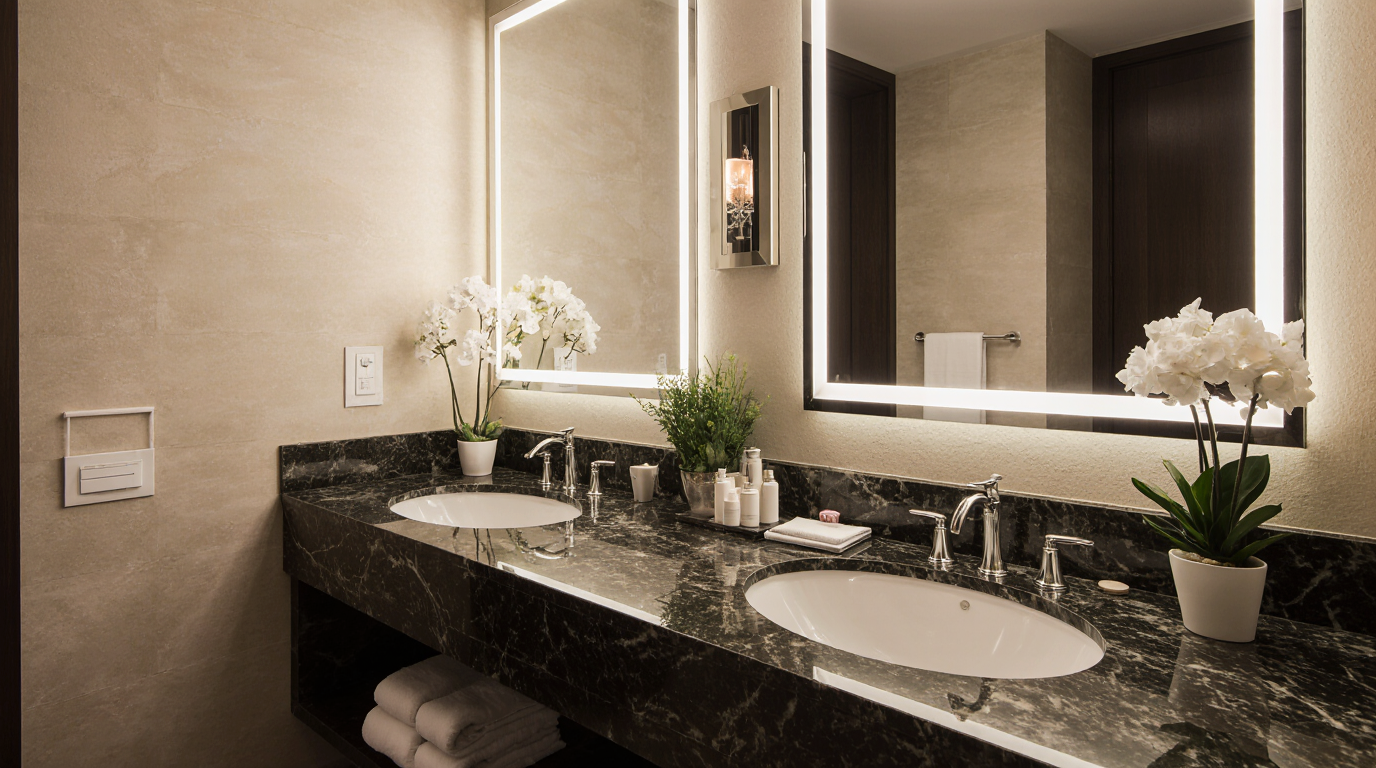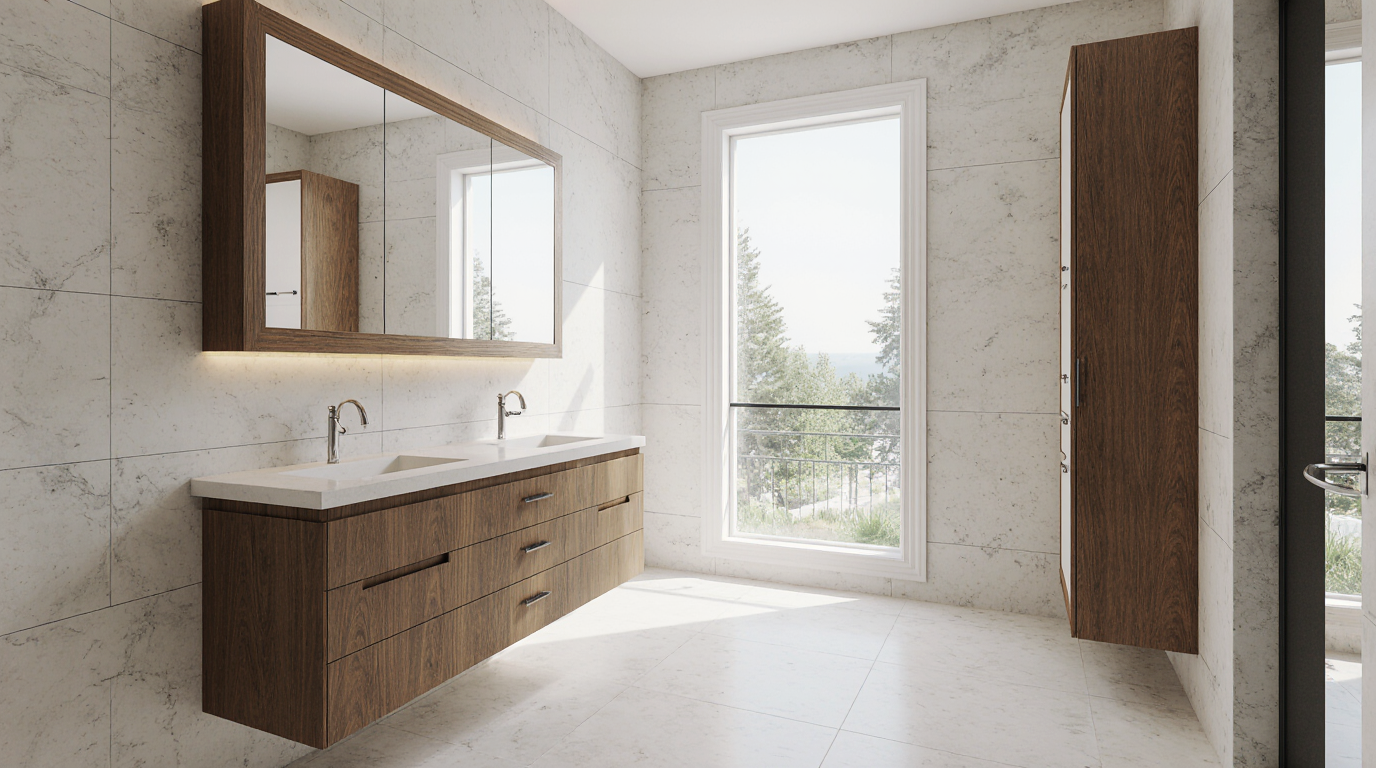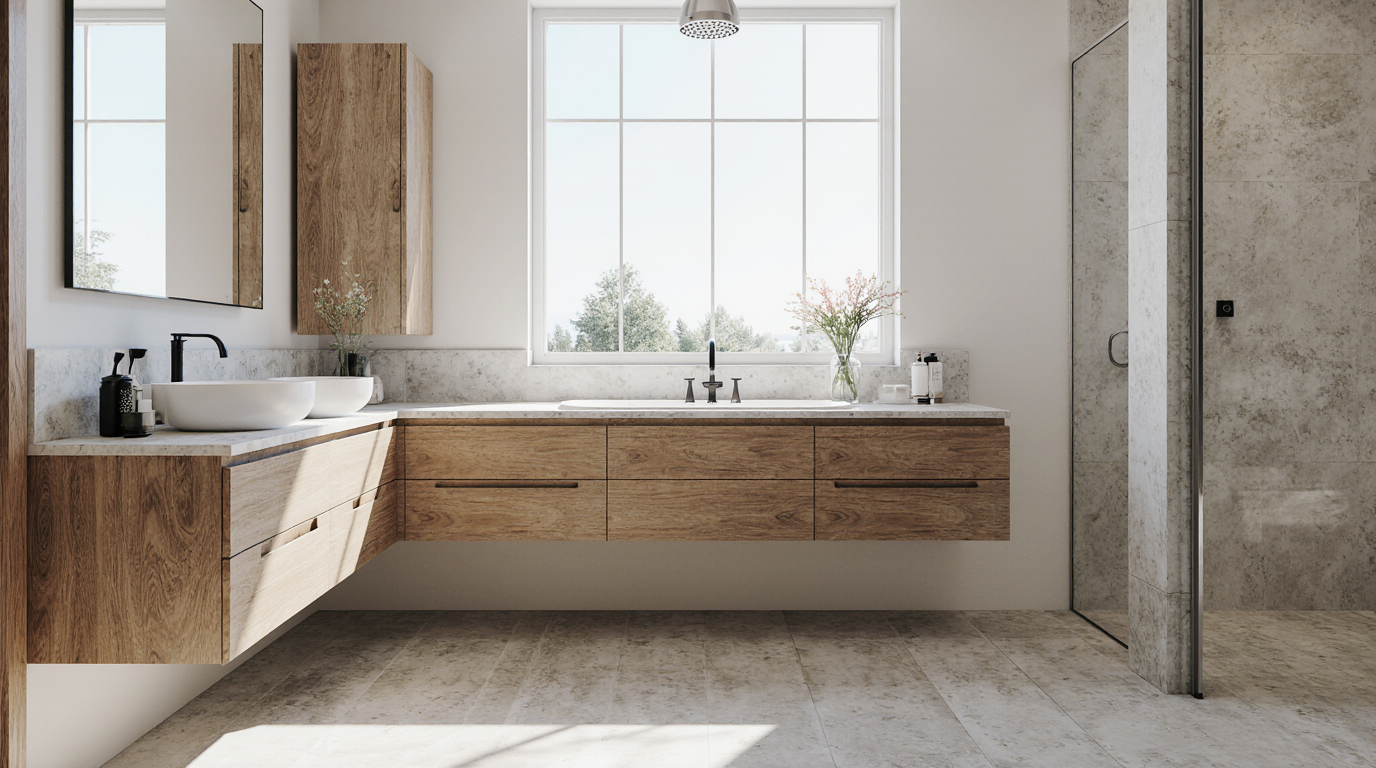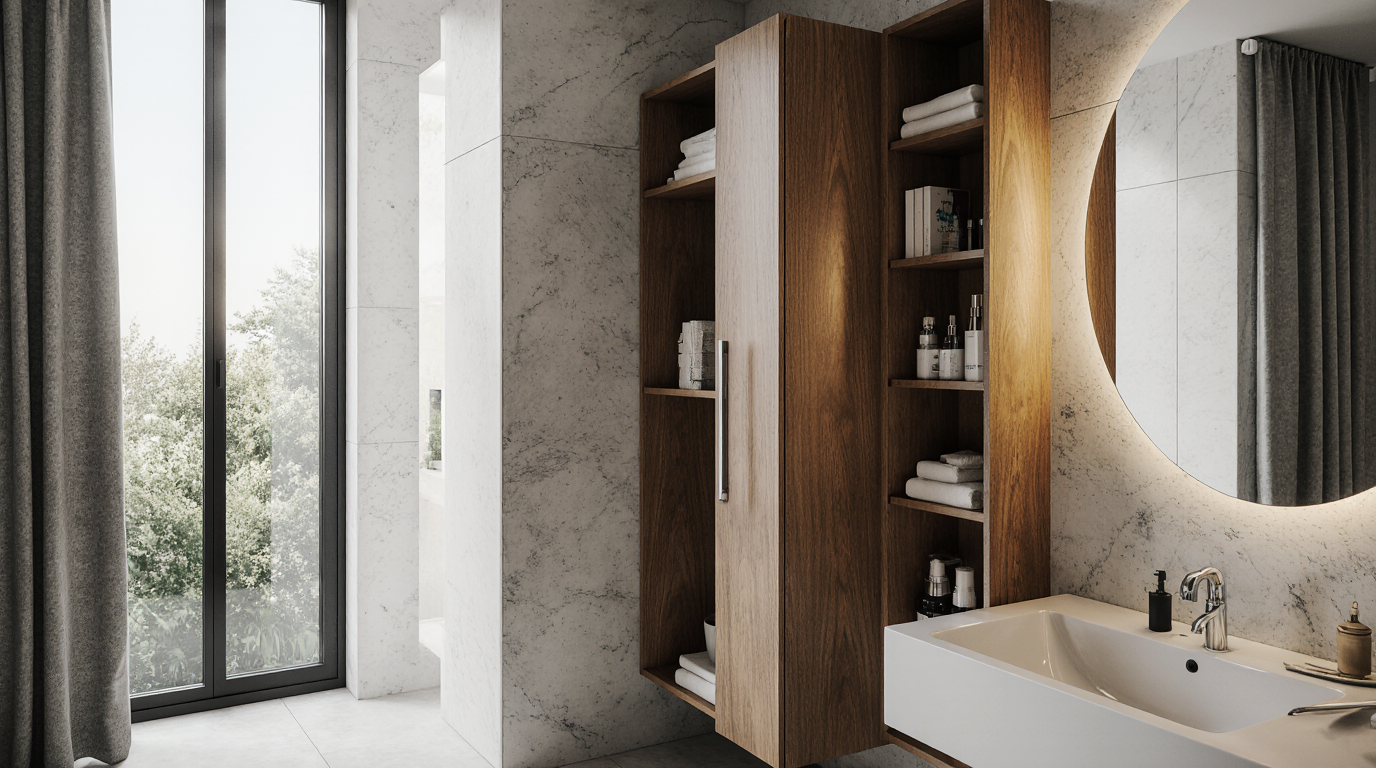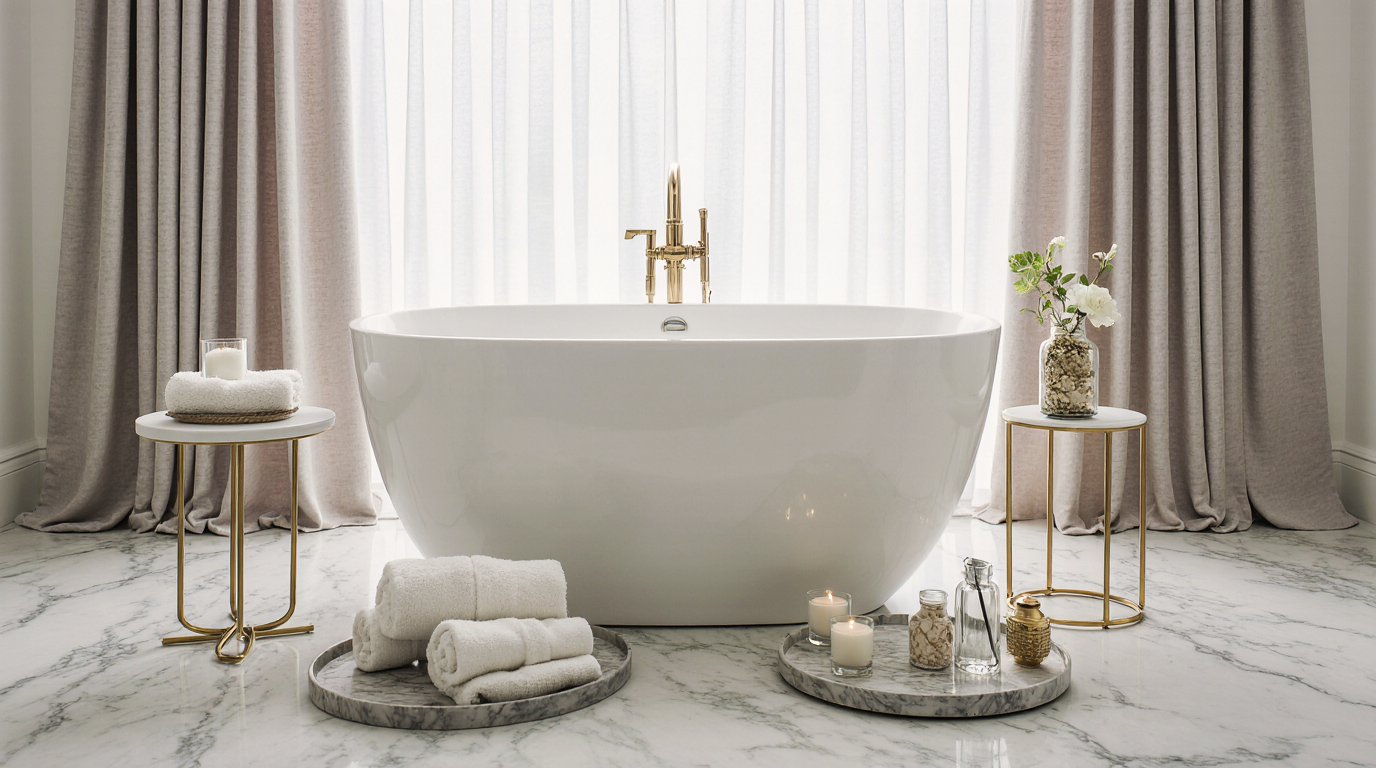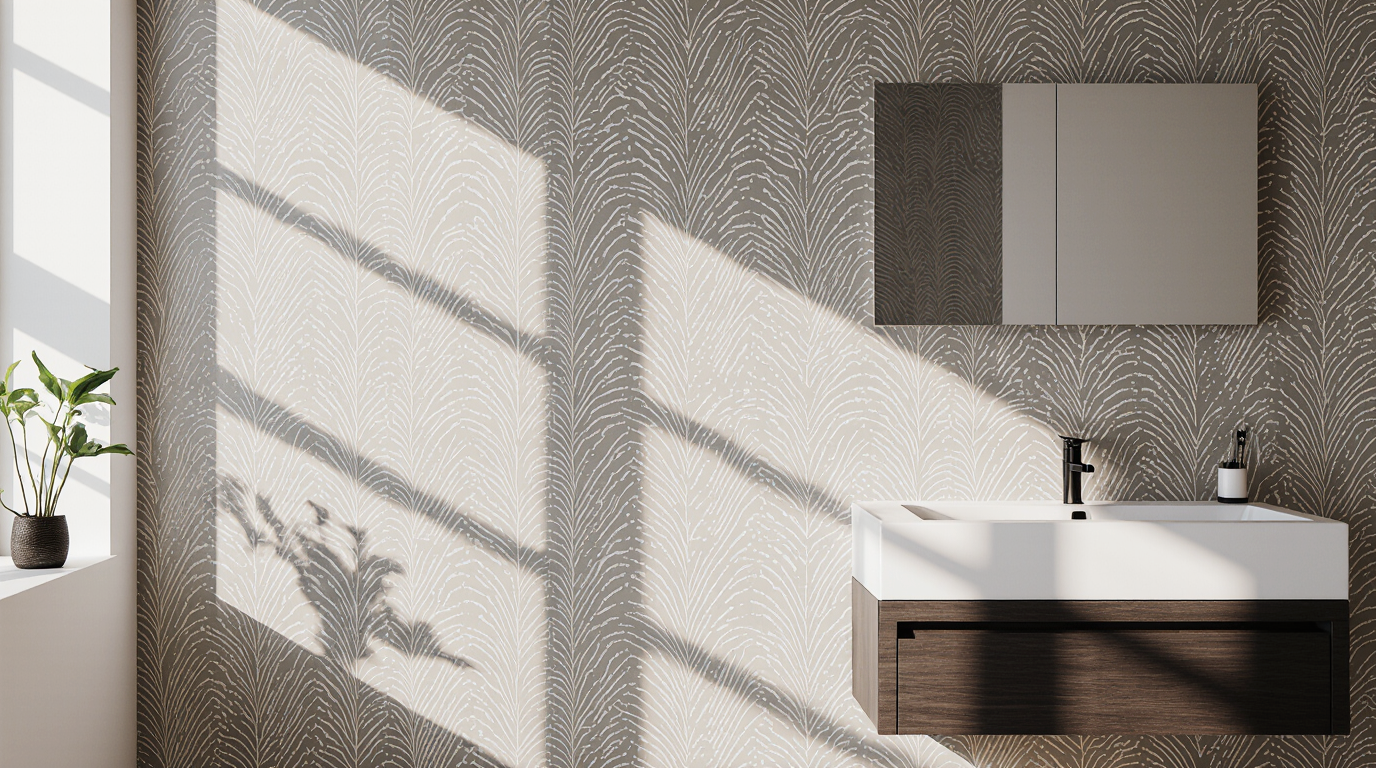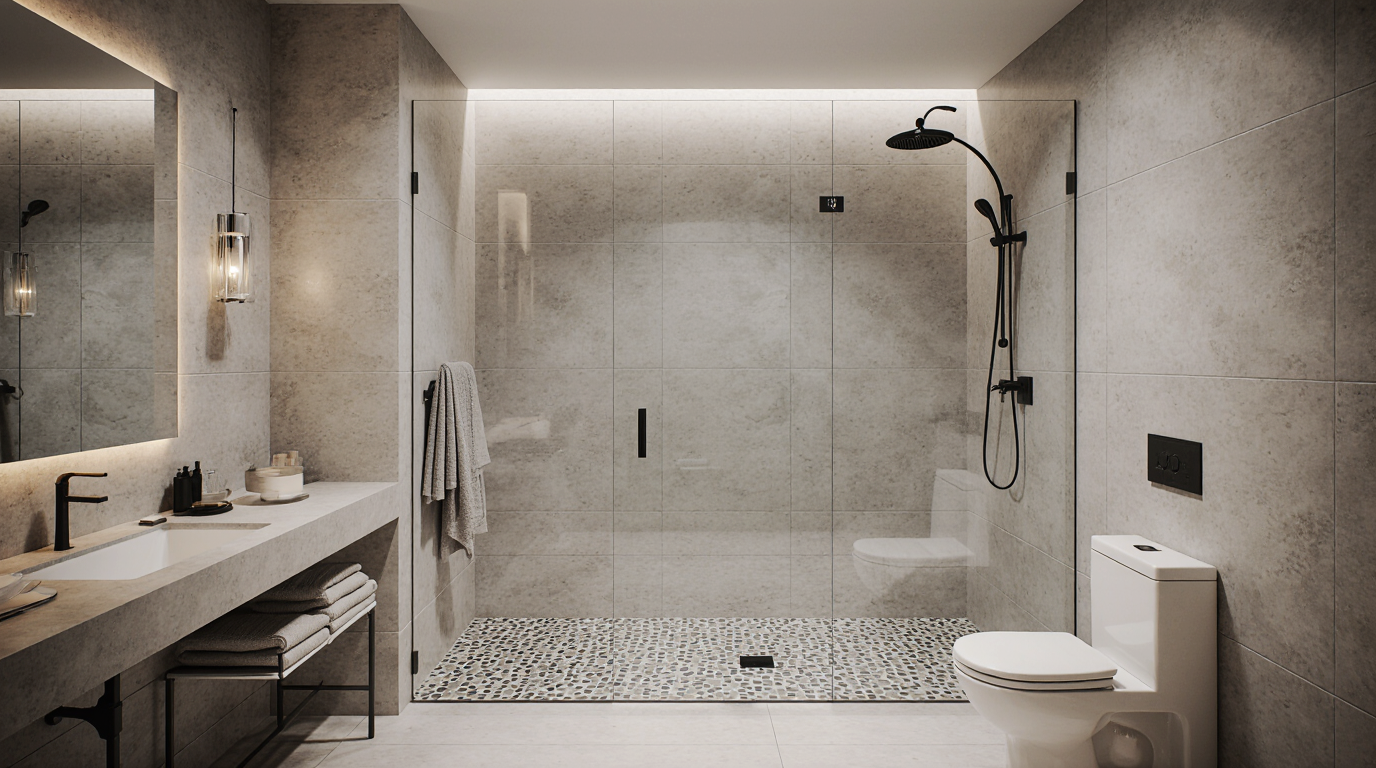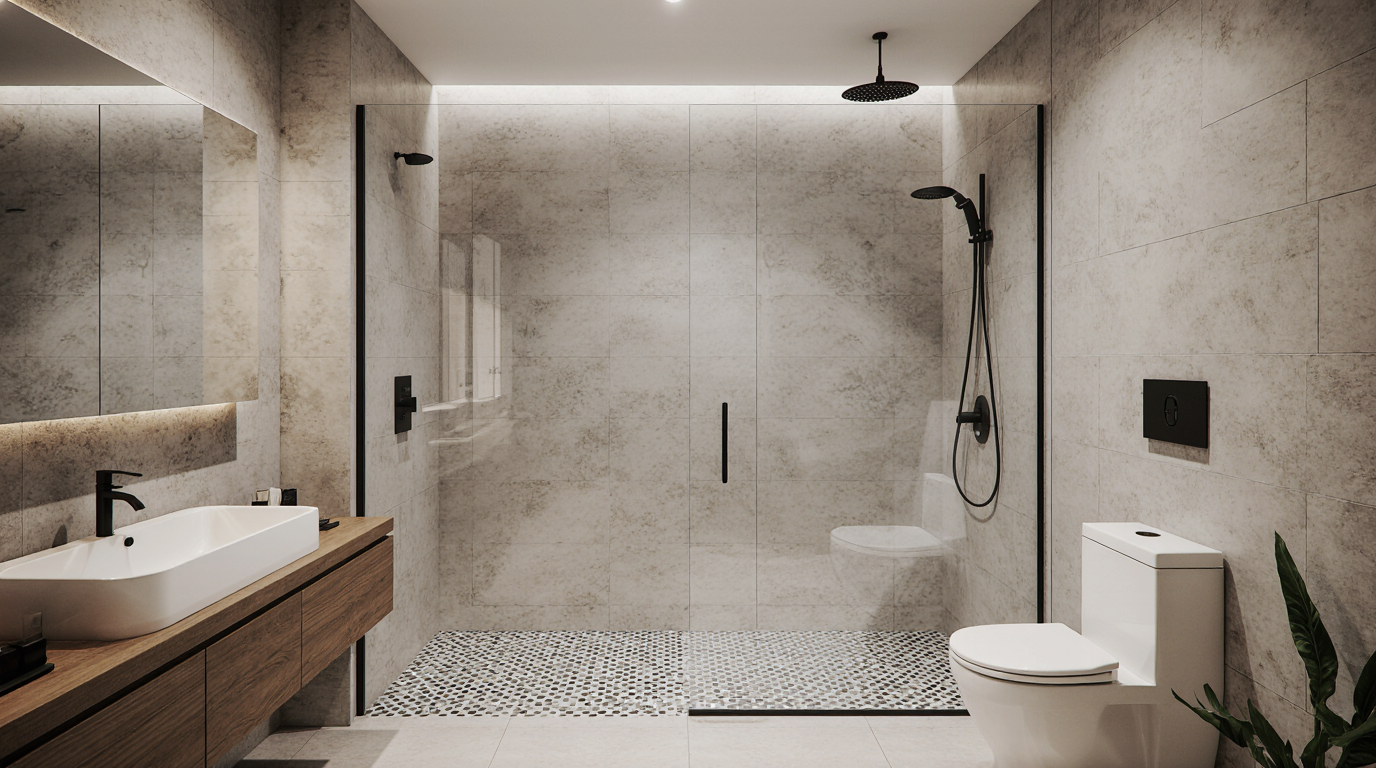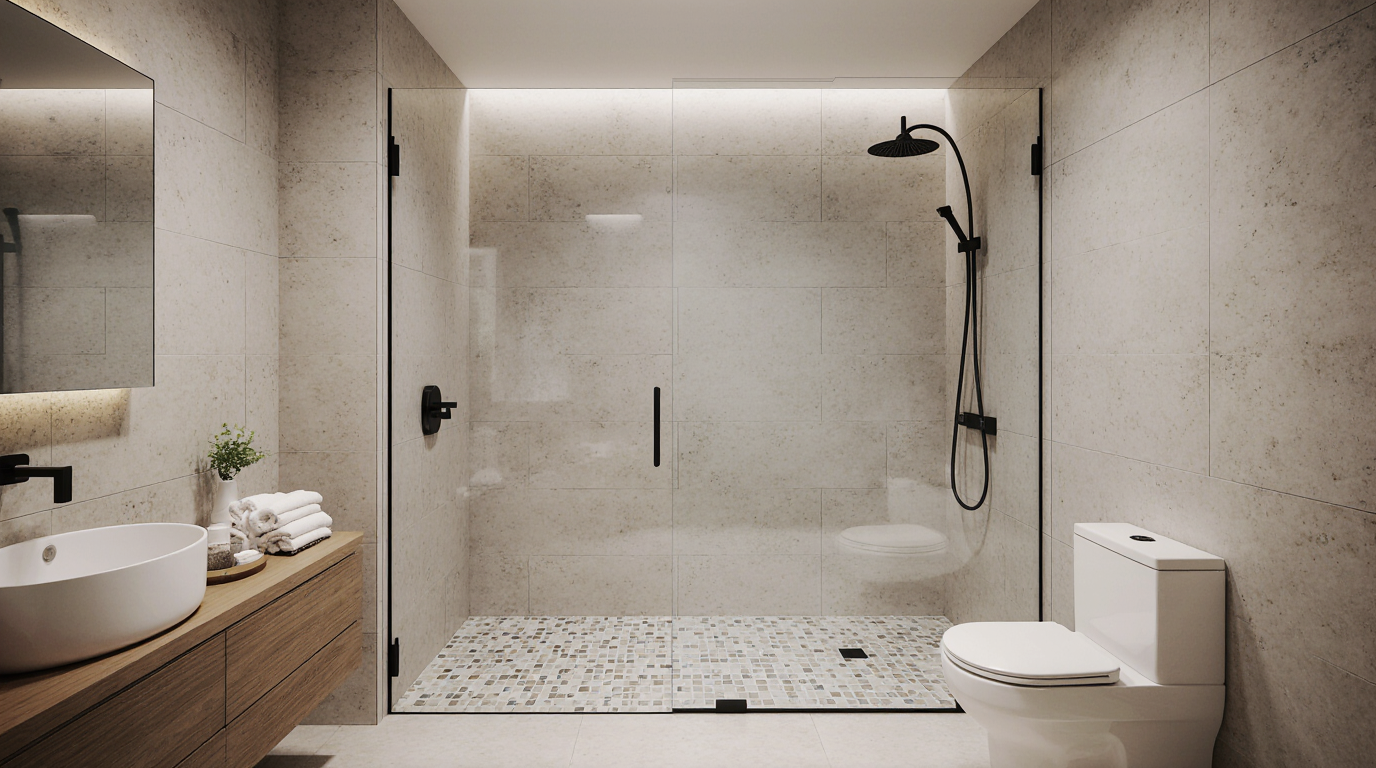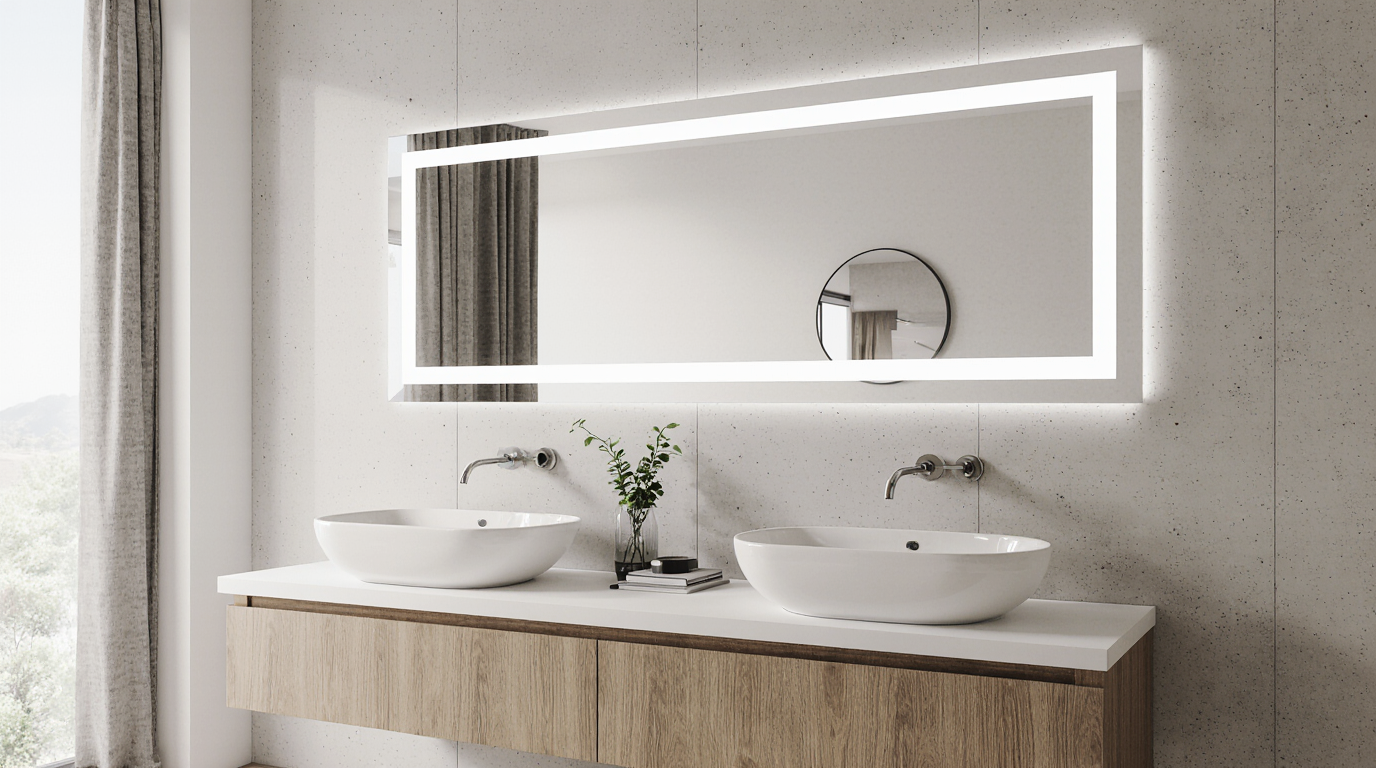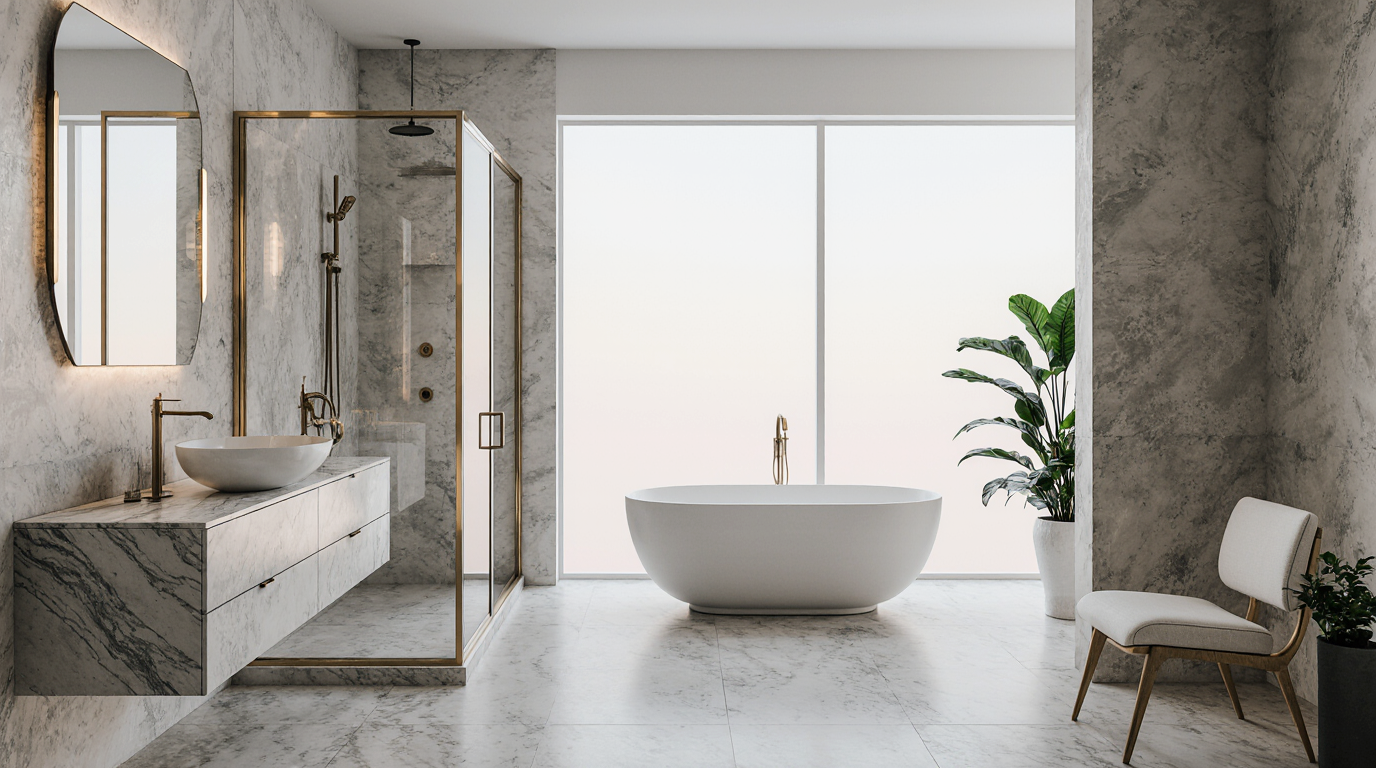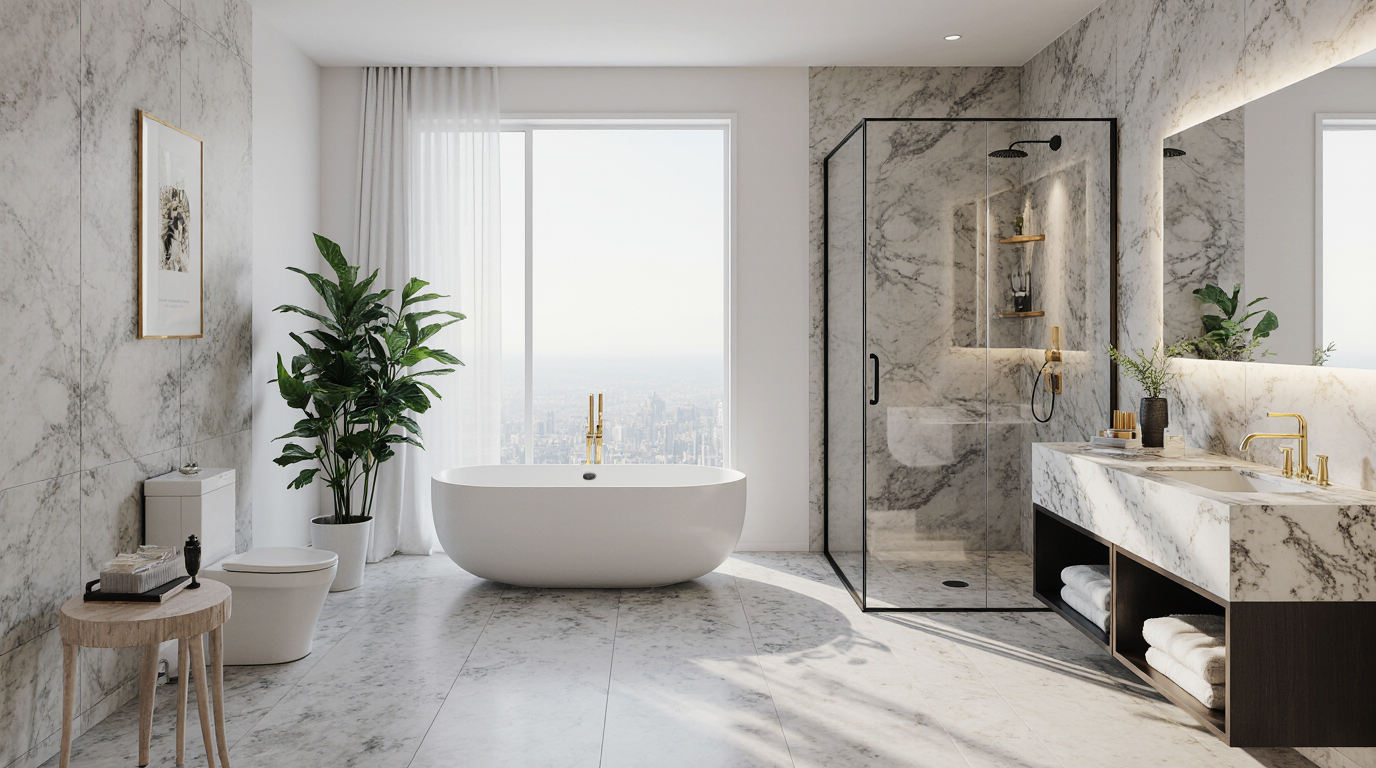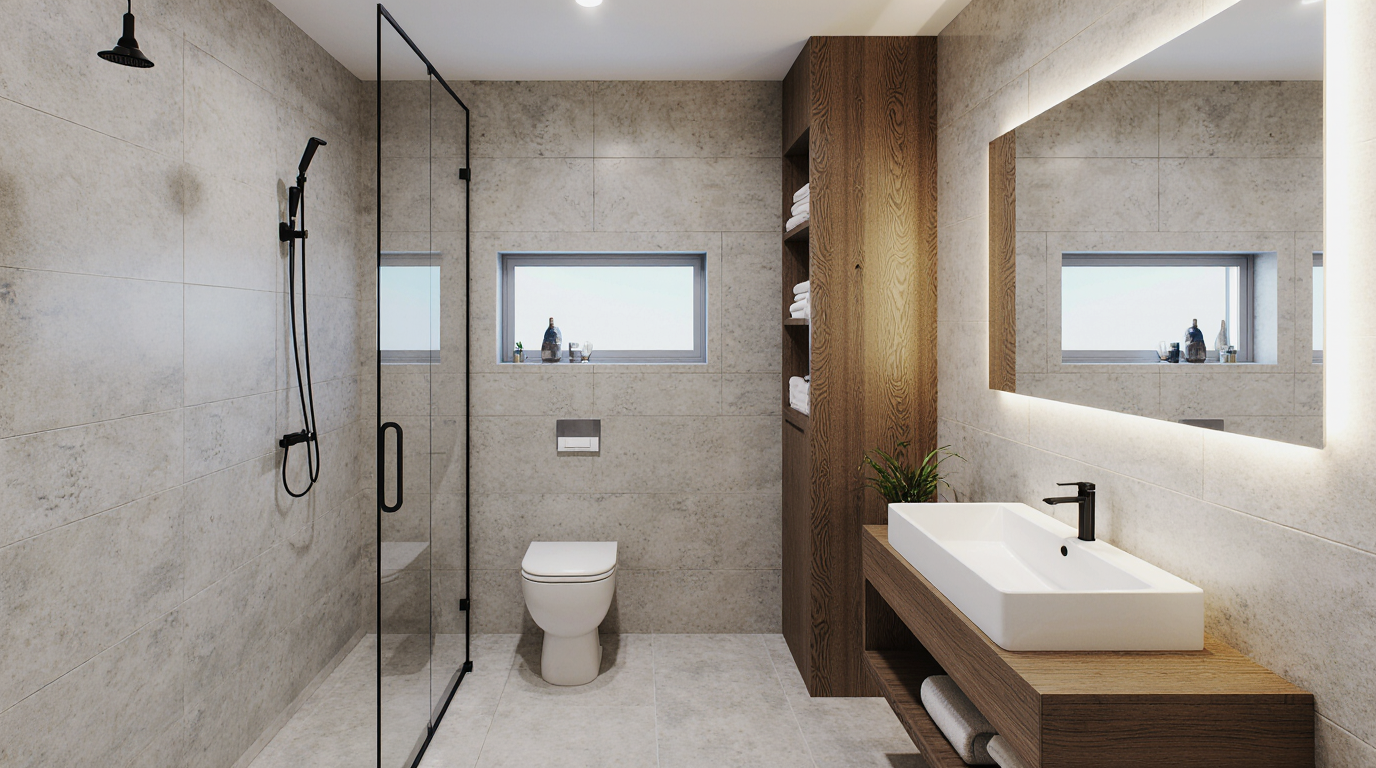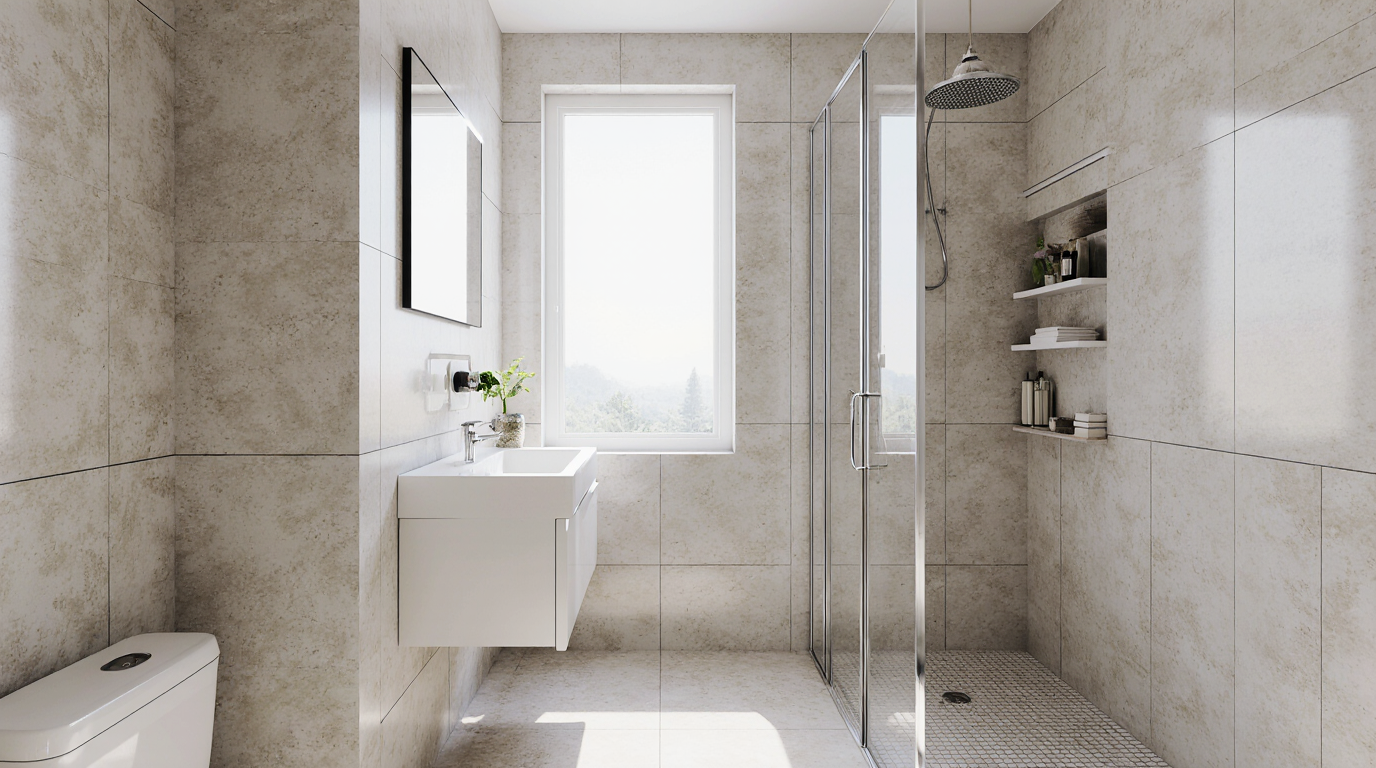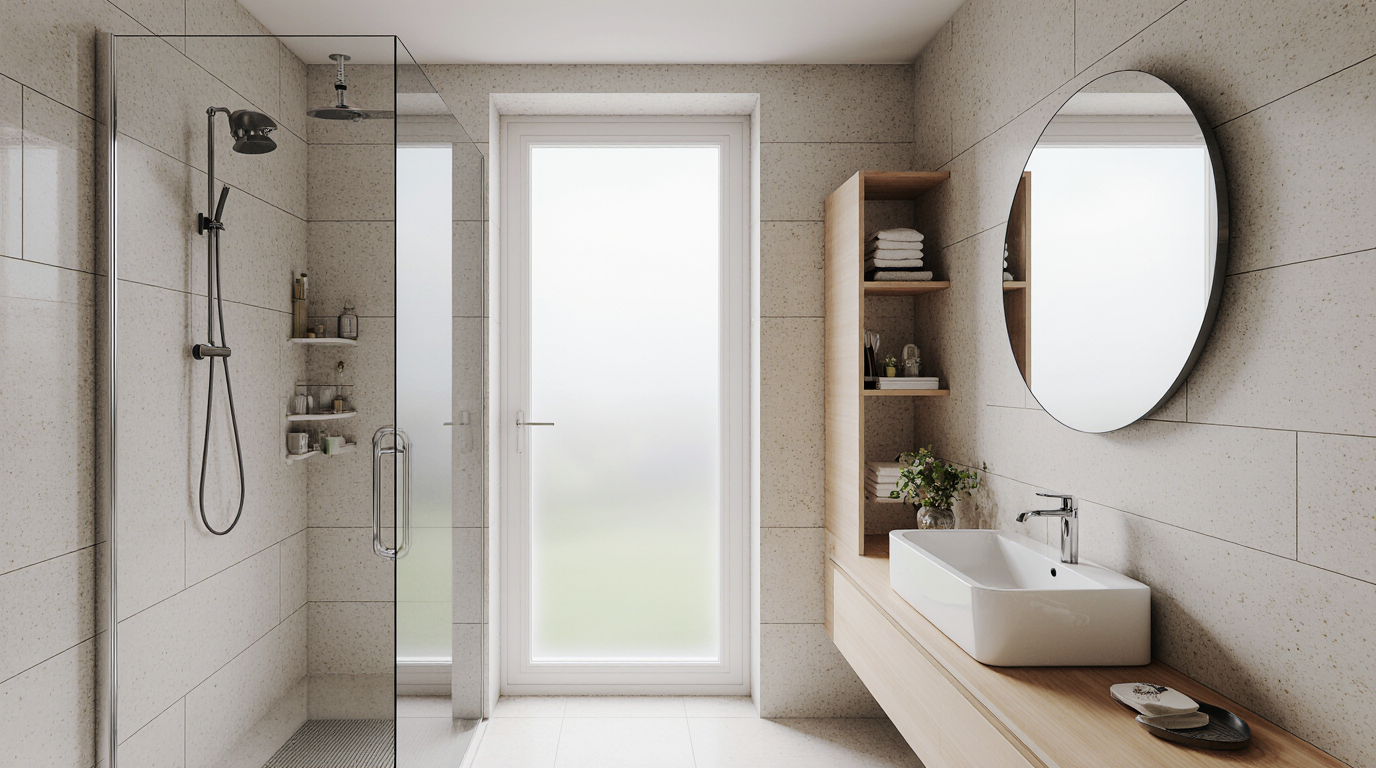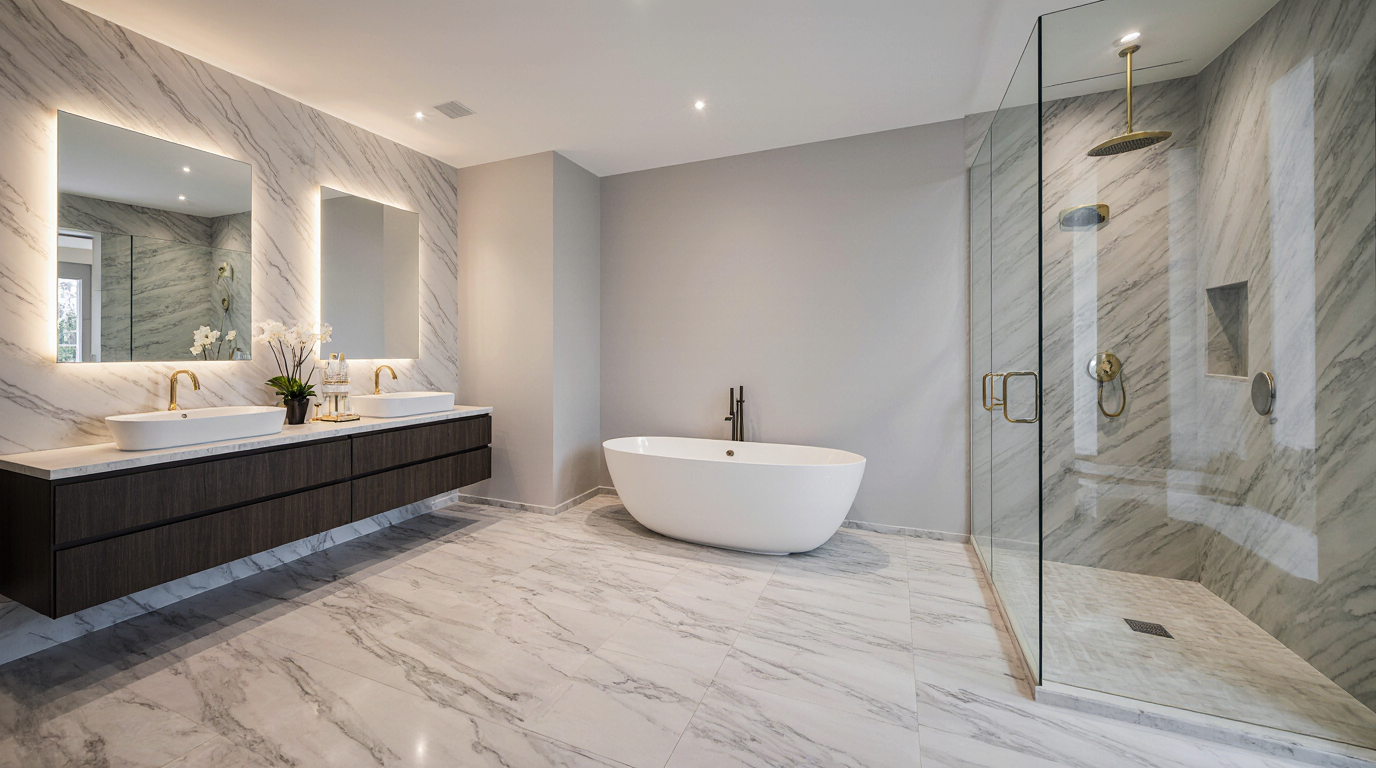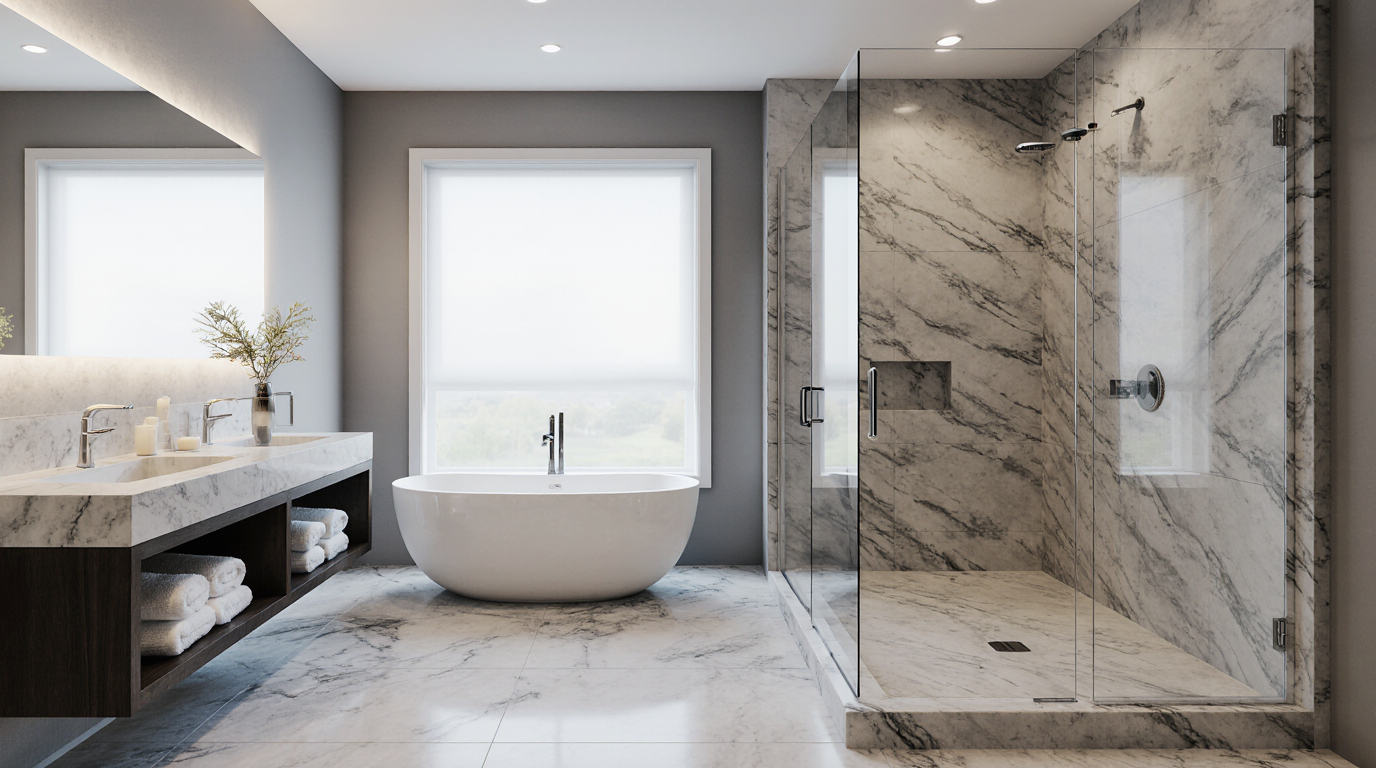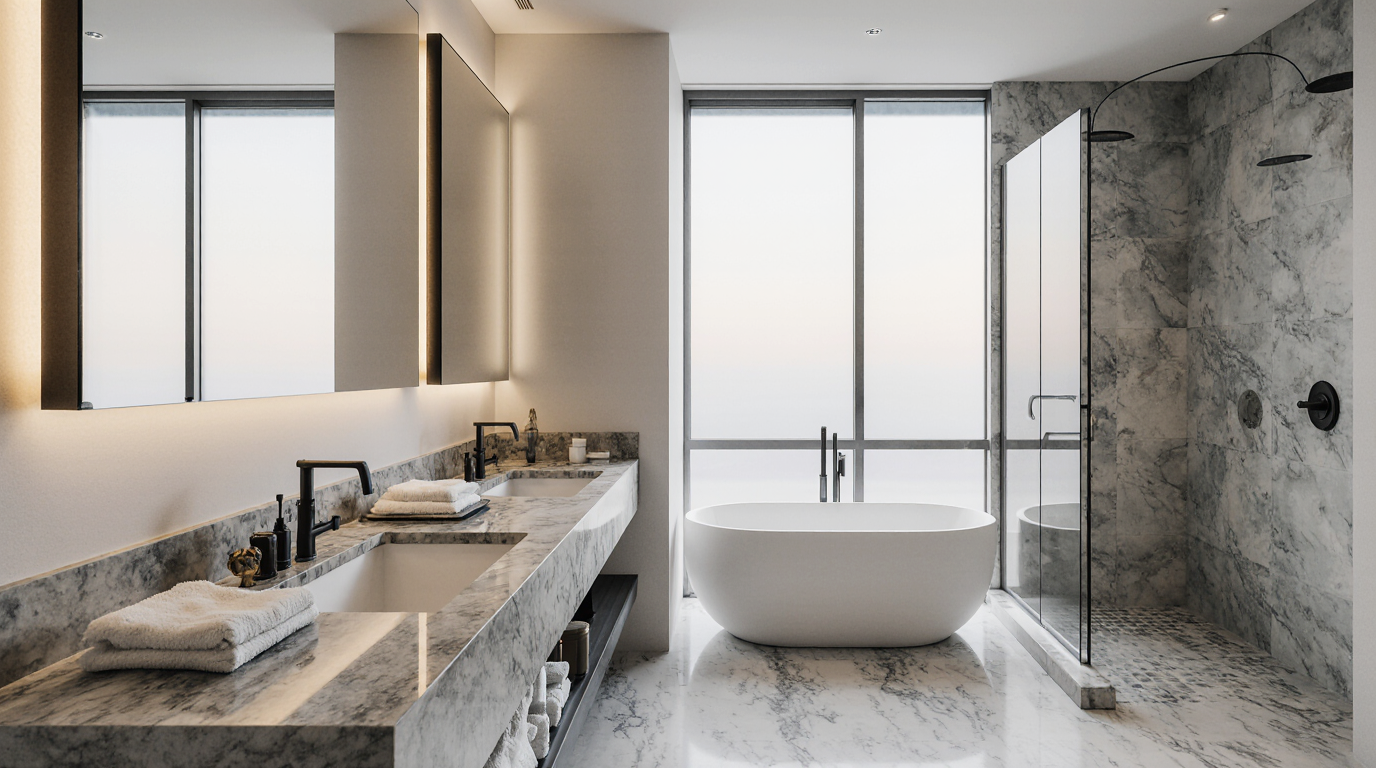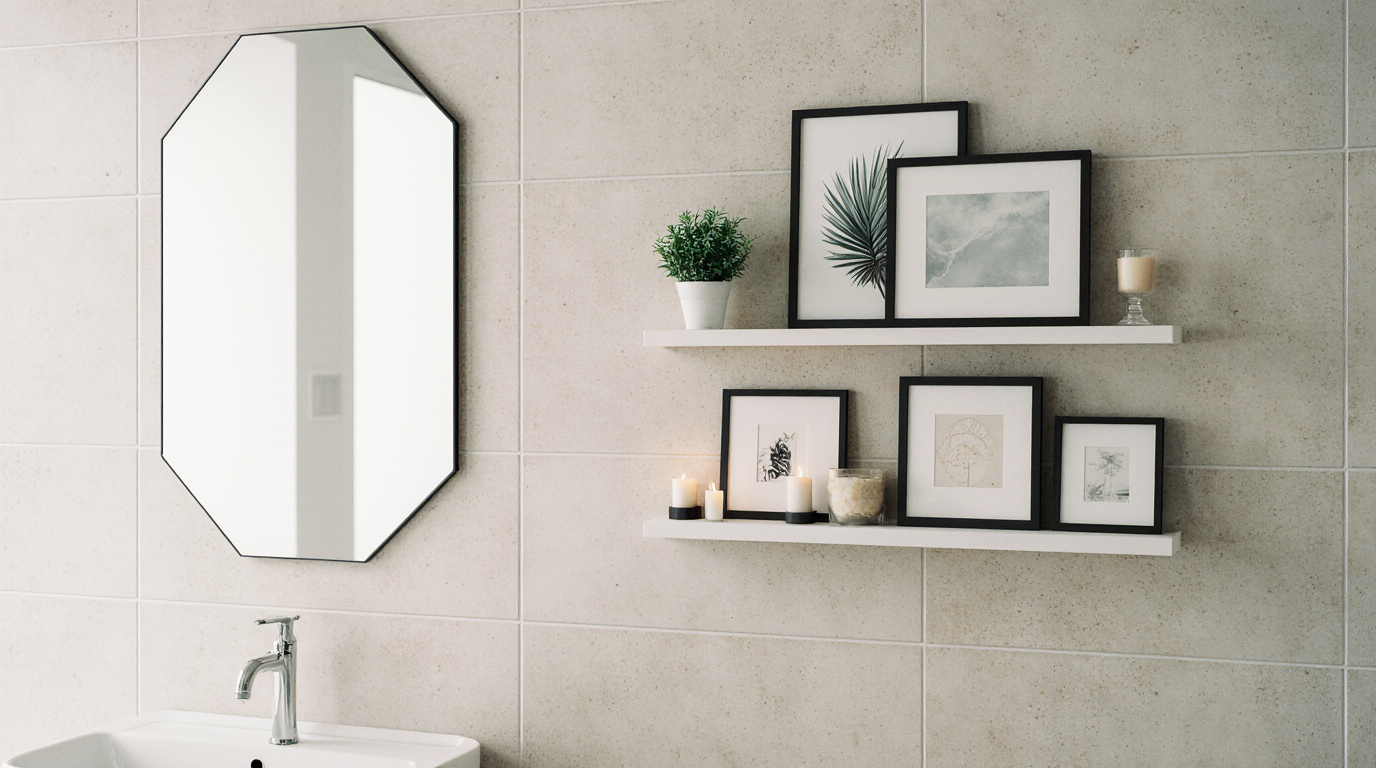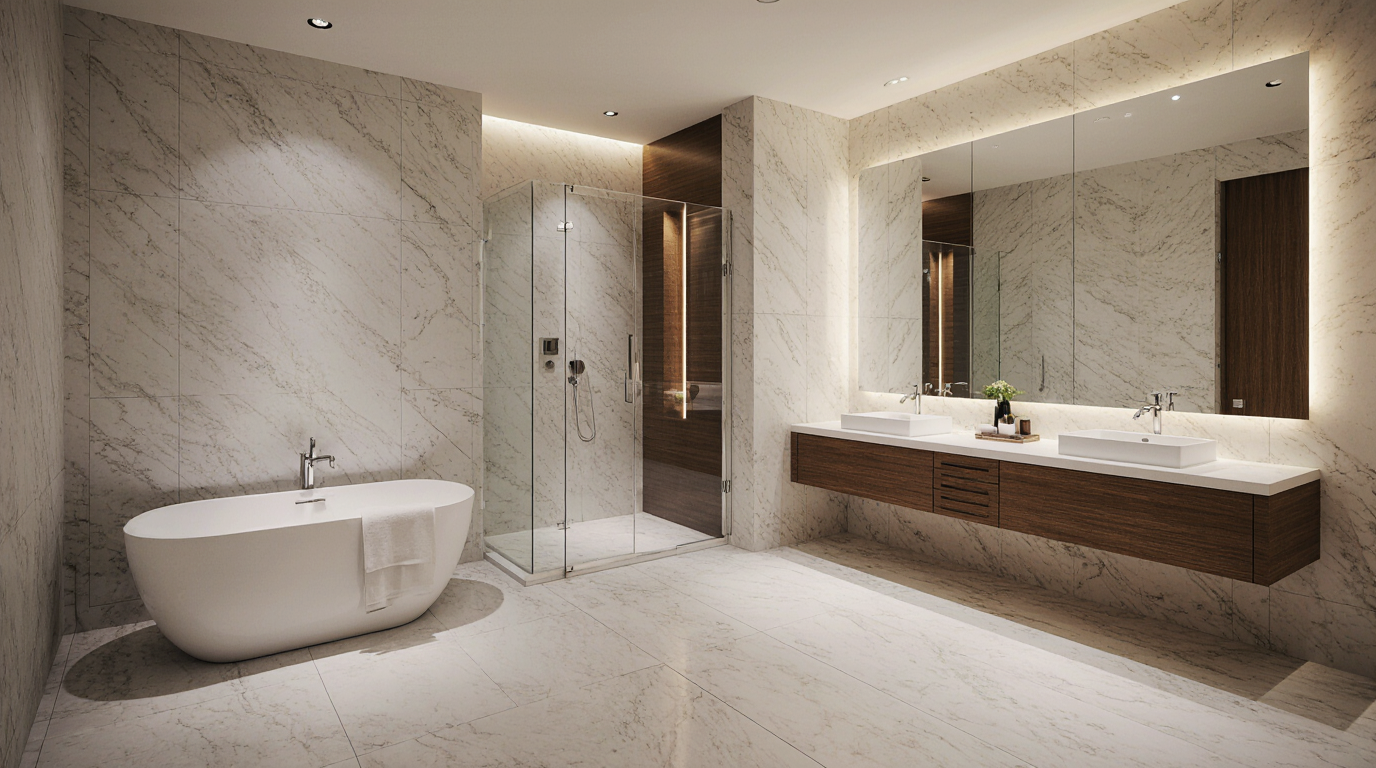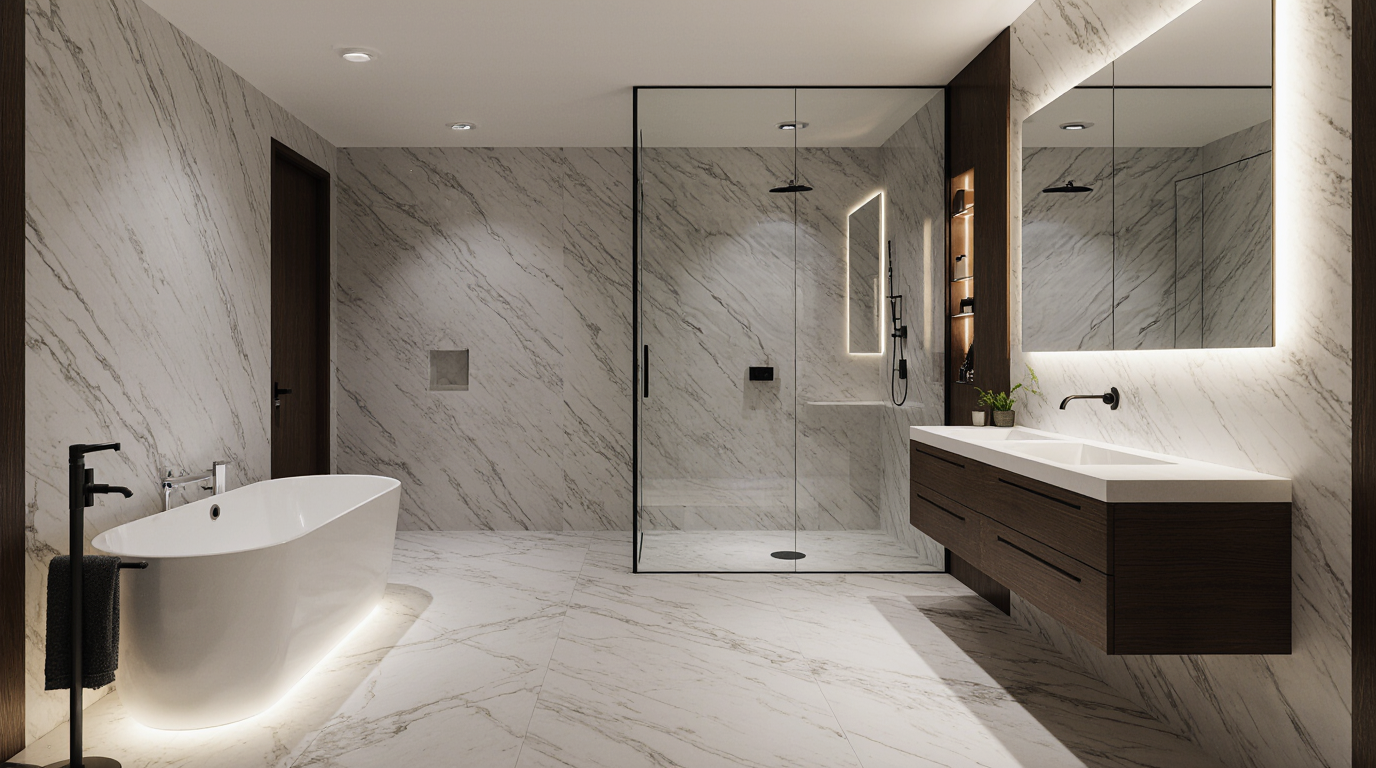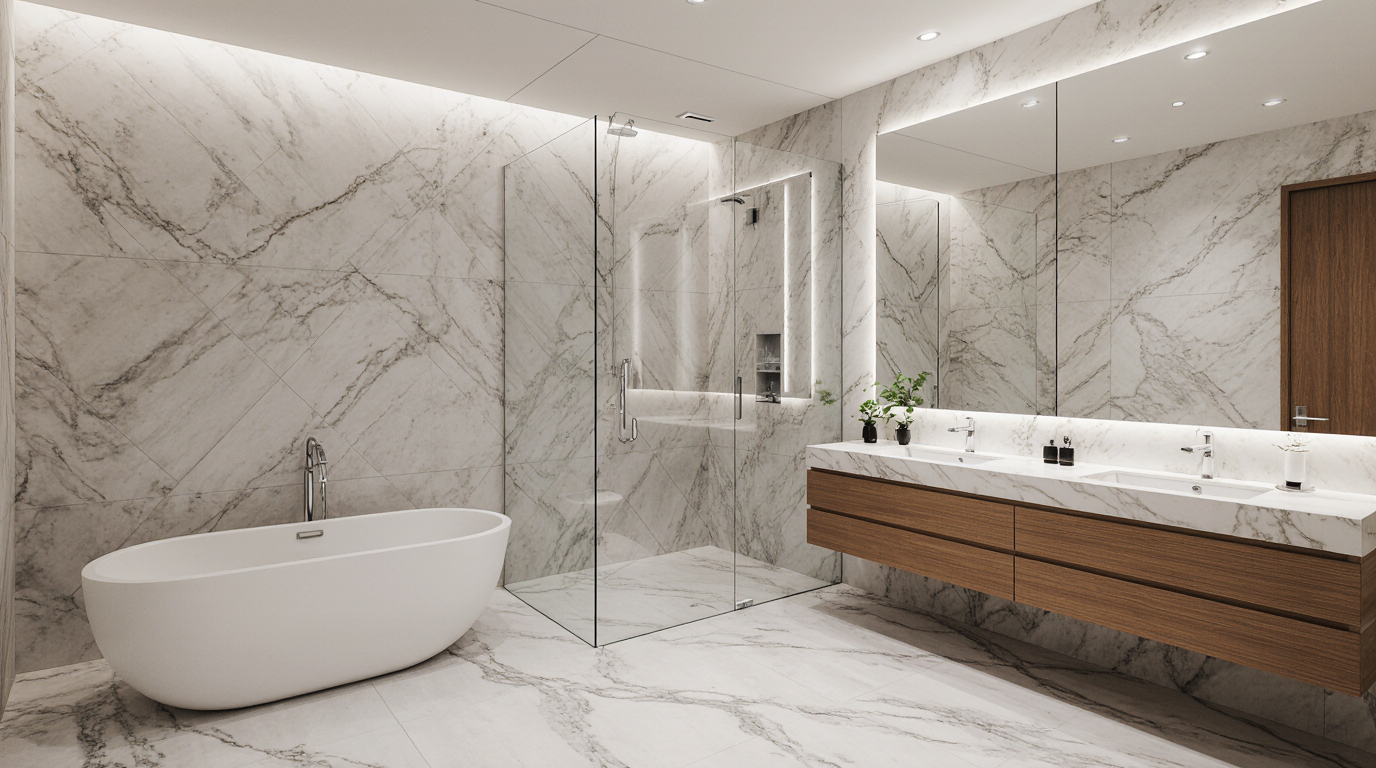Bathroom Design
The new-age bathroom transcends its simple purpose to become a true home sanctuary, a space focused on wellness and rejuvenating moments. Current bathroom design is heavily influenced by a desire for minimalism and organic materials, focusing on creating an atmosphere of calm and timeless elegance.
The new-age bathroom transcends its simple purpose to become a true home sanctuary, a space focused on wellness and rejuvenating moments. Current bathroom design is heavily influenced by a desire for minimalism and organic materials, focusing on creating an atmosphere of calm and timeless elegance.
A fundamental pillar in achieving this rests upon the careful curation of surfaces. The professional inclination is toward minimalist, seamless surfacing that minimize grout lines, resulting in a smooth, uninterrupted visual flow. Natural stone, particularly marble with its distinctive marbling, is still the ultimate selection for vanity tops and feature walls, instantly adding a layer of unrivalled luxury. The integration of smart technology is now absolutely essential, extending past basic functionality to include illuminated vanity mirrors with built-in anti-fog and mood-setting lights, and even thermostatic shower controls that remember preferred temperatures.
The priority placed on an atmosphere of retreat means that lighting design has become a decisive factor, moving away from harsh overhead fixtures to layered illumination. This encompasses low-level floor lighting for nighttime navigation, designer fixtures at eye-level to provide shadowless task lighting, and dimmable accent lighting to set a mood of deep relaxation. Freestanding soaking tubs continue to be a highly desired design feature, serving as a sculptural focal point that invites long, luxurious bathing rituals. For the shower space, the trend is firmly in favor of open showers featuring clear glass partitions, which enhance the feeling of openness and support the airy, expansive aesthetic demanded by today's homes. Finally, hardware finishes are evolving, with brushed gold and matte black finishes providing a sharp, modern counterpoint to pale tiles and porcelain, imparting a signature of intentional design that heightens the holistic experience.
Beautiful BathroomsThe bathroom today is more than just functional; it's a personal sanctuary, a space dedicated to self-care and relaxation. The key to beauty in this intimate room is a thoughtful blend of aesthetics and utility. Integrating natural elements, such as wooden features or strategically placed indoor plants, can immediately soften a clinical look, making the room into a tranquil, spa-inspired escape that caters to your well-being.
A beautiful bathroom often depends on the selection of high-quality materials and harmonious color palettes. A timeless elegance is found in white marble, which reflects light, helping the space appear larger and brighter. Alternatively, richly pigmented hues in a powder room can create a dramatic, luxurious jewel-box effect. The key is consistency—seeing to it that the vanity, flooring, and wall coverings are coordinated to tell a cohesive design story, whether that story is one of minimalist tranquility or bold opulence.
Lighting plays a critical, yet often overlooked, role in defining a beautiful bathroom. Rarely is harsh overhead lighting flattering or relaxing. Instead, consider layering light sources: task lighting around the mirror for perfect grooming, ambient ceiling fixtures, and perhaps even a stylish chandelier or wall sconces to introduce a focal point and a warm glow. Dimmers are essential for adjusting the mood, allowing you to switch from bright, functional lighting in the morning to soft, calming light for an evening soak.
Finally, the finishing touches elevate a design from nice to truly beautiful. Select stylish hardware—brushed brass or matte black can provide a sophisticated contrast to lighter tiles. Smart storage solutions, such as recessed niches in the shower or a well-organized vanity, keep clutter hidden, which is paramount for maintaining a sense of serenity. When the choice of every detail, from the towel hooks to the soap dispenser, is intentional, the bathroom becomes an oasis of true, enduring beauty.
Custom Shower LayoutDesigning a custom shower layout offers a unique opportunity to tailor a daily routine space precisely to your needs and lifestyle, moving beyond standard, restrictive dimensions. A successful layout prioritizes user experience, accessibility, and efficient use of the available space. The first consideration should always be flow—you must consider how the shower relates to the rest of the bathroom and how entry and exit can be made seamless and safe.
The shower’s footprint and enclosure style is one of the most impactful decisions. Walk-in showers, which eliminate a threshold and typically use frameless glass panels, have become the ideal option for a modern, expansive feel. For a luxurious design, consider an extra-large space that accommodates multiple shower heads, including a rain shower from the ceiling and adjustable body jets, turning a simple rinse into a hydrotherapy experience.
Beyond the physical dimensions, the internal features of a custom shower are where personalization truly shines. A built-in bench is invaluable for comfort, shaving, or for those with mobility concerns. Storage niches, strategically recessed into the wall, keep shampoo bottles hidden and are far superior to caddies over the door. Furthermore, the positioning of the controls is vital: place them near the entrance so you can turn on the water and adjust the temperature without getting wet.
Choosing the correct tile for a custom shower layout influences both aesthetics and safety. Large-format tiles minimize grout lines, making cleaning easier and providing a sleek, uniform look. For the shower floor, however, smaller tiles or a slightly textured surface are often recommended to provide better grip and ensure proper drainage toward the central drain. A well-planned custom layout integrates these functional and beautiful elements into a perfect, daily ritual space.
Luxury Bathroom SuitesA true luxury bathroom is not simply defined by expensive fittings, but as a holistic architectural design and a dedicated wellness hub. These suites are defined by generous scale, flawless execution, and an unwavering commitment to sensory pleasure. The initial step in creating this environment involves dedicating ample square footage, allowing for separation between distinct zones—the shower and bathing zone, grooming area, and seating or lounging corner—to foster a feeling of openness and calm.
The selection of materials is fundamental to defining a luxury suite's character. Natural stone, such as exotic granite, striking book-matched marble, or shimmering onyx, is often used to cover expansive walls or create a stunning focal point around the tub. These materials are investments, but their distinct patterns and tactile surface provide a depth and richness that cannot be replicated. Combining different textures, like polished stone alongside rich wood grain or sleek chrome accents with opaque glass, adds another level of aesthetic refinement.
Technology is subtly woven into the design of a genuinely luxurious bathroom. Features might include smart toilets with automated functions, floor heating systems that can be programmed remotely, and digital shower controls that memorize preferred temperatures and water pressure settings. Entertainment systems, concealed behind mirror surfaces, allow for access to audio or video entertainment without disrupting the sophisticated aesthetic. This subtle integration ensures maximum ease and accessibility are readily available.
The definition of a luxury suite culminates in the inclusion of dedicated relaxation features. This could manifest as a large, sculptural soaking tub—perhaps a traditional Japanese-style ofuro or a distinctive copper bath—positioned near a large window with a view. Alternatively, a steam shower or a personal sauna offers therapeutic benefits, turning the suite into a daily retreat. When thoughtful design meets unparalleled comfort, the result is a bathroom that is truly a sanctuary of modern luxury living.
Large Bathroom Wall DecorIn a large bathroom, expansive wall space presents a wonderful design opportunity but also a challenge: how to fill the area in a way that is striking, unified, and free from visual noise. Unlike smaller rooms where a single mirror might suffice, a large bathroom demands confident, intentional wall decoration that complements the scale of the room, ensuring the walls feel grounded and deliberate rather than empty and overwhelming.
One effective approach is the use of oversized artwork. A single, large-scale statement piece—be it a minimalist abstract painting, a colorful piece of photography, or a large-scale watercolor—can instantly become the room's main visual anchor, especially when hung above a freestanding tub or a double vanity. Ensure the art is well-framed and sealed against humidity, or opt for pieces made from materials like canvas or metal which naturally resist humidity, preserving the artwork’s condition.
Beyond traditional art, using innovative wall finishes can serve a decorative purpose on its own. Consider a feature wall clad in a highly tactile surface, such as weathered wood panels, geometric 3D tiles, or a bespoke mosaic design. This adds structural flair and a sense of touch without relying on separate decorative items. When applied to the wall opposite the entrance, it immediately captures attention, emphasizing the bathroom's spaciousness and thoughtful design.
Furthermore, leveraging mirrors is essential in a large space, not just for function, but for decor. Instead of one large mirror, consider two ornately framed mirrors over the double sink, or a collection of round or angular mirrors hung in a cluster. This approach breaks up the wall, enhances the design's intricate appeal, and reflects light beautifully, further enhancing the feeling of luminosity and opulence within the grand scale of the large bathroom.
Shower Remodel CostUnderstanding the cost of a shower remodel is vital for anyone planning a home improvement project, as expenses can vary widely depending on the project's size, the materials used, and the labor needed. Typically, a simple, surface-level shower update involving new tile, a standard fixture replacement, and a basic glass enclosure can cost much less than a full, bespoke renovation that involves relocating plumbing and reconfiguring the layout.
The main influence in the overall budget is typically the supplies. For the best value, choose standard ceramic or subway tiles, while natural stone like marble or granite, or designer glass mosaics, will elevate the expenditure. Similarly, the hardware selections range from basic chrome taps to high-end digital valves, multiple showerheads, or specialized finishes like oil-rubbed bronze or matte black, each escalating the material expenditure.
The price of labor is a second key consideration and are highly dependent on the intricacy of the job. A remodel that requires tearing down and rebuilding walls, moving the drain line, or installing a new ventilation system demands skilled labor, increasing the duration and the price of the project. If you are opting for a custom shower with elaborate tile work or intricate glass enclosures, you'll face greater installation charges due to the specialized skill and time required.
To manage the shower remodel cost effectively, prioritize the elements that offer the greatest long-term benefit. Investing in high-quality waterproofing is a must-do, as leaks can lead to much costlier fixes later. Homeowners often find that spending more on a robust, eye-catching tile and a high-efficiency shower system provides the most immediate and long-term satisfaction, balancing necessary functional costs with desirable aesthetic upgrades.
Walk-in Shower RemodelA walk-in shower remodel is one of the most transformative upgrades you can make to any bathroom, immediately improving the area with a modern, resort-style appearance. Beyond the visual appeal, this renovation is extremely useful, offering barrier-free access that improves safety and accessibility, a key consideration for long-term home value. The open design removes visual clutter, making even a compact washroom feel much bigger and more opulent.
The foundation of a successful walk-in shower lies in impeccable waterproofing. Unlike standard showers, a true walk-in setup often involves a curbless or low-curb design, which requires a professionally sloped floor and durable waterproof barrier. It’s vital to use high-grade systems such as those from Schluter or Wedi to ensure a watertight enclosure, protecting your home from moisture damage. Prioritizing quality materials and professional setup early on prevents costly issues down the line.
When it comes to design, maximizing light and space is paramount. Opting for a frameless glass enclosure is a smart choice, as the clear glass allows light to pass through uninterrupted, enhancing the open feel. Big tiles for the walls and floor, often continued from the main bathroom floor into the shower area, reduce the number of grout lines, and create a seamless, cohesive look. Consider adding a built-in niche for toiletries and a linear drain for a sleek, contemporary finish.
Finally, customize your area with carefully chosen fittings. A dual or rainfall shower head can turn a daily routine into a rejuvenating experience. Pair these with modern tapware in finishes like matte black or brushed gold to bring in a stylish element. A well-executed walk-in shower remodel merges function and style, creating a high-impact space that is visually stunning and designed for your requirements.
Affordable Bathroom RenovationsAchieving a stylish bathroom renovation doesn't have to break the bank; the key is smart planning and making strategic decisions. The most critical rule for maintaining a low budget is to avoid moving the plumbing. Relocating the toilet, sink, or shower fundamentally changes the layout and dramatically increases labor costs, which is often the most expensive part of any remodel. By sticking to the existing 'footprint', you save money for more visible cosmetic improvements.
Prioritize high-impact changes to surfaces within your budget. Instead of fully replacing intact but dated tiles, think about an expert-applied epoxy coating for a new surface. This offers a brand new aesthetic for a fraction of the cost of demolition and re-tiling. Similarly, rather than installing a brand new vanity unit, a simple paint job on the existing cabinet and a replacement countertop or new hardware can provide a massive visual update for minimal expense.
Another effective, low-cost strategy is to update the fixtures. Installing new, modern, and matching fixtures—such as the faucet, shower head, and towel rack (in finishes like matte black or polished chrome)—will immediately update the room's look. New lighting is also a powerful tool; switching to energy-efficient LED fixtures or adding a stylish mirror with integrated backlighting can brighten the space and make it feel far more sophisticated.
Where possible, remember to tackle basic tasks yourself (DIY), like painting, installing a new light (with the power safely off!), or putting down a vinyl floor. Prioritize the quality of your key purchases, like the toilet or vanity top, and look for sales or clearance items for your tiles and accessories. An affordable renovation is about being resourceful and selective with your spending to achieve the biggest visual return.
Small Bathroom RemodelA small bathroom remodel presents a fantastic opportunity to maximize every inch of space, turning a cramped utility room into a highly functional and stylish sanctuary. The design challenge is to create an illusion of space and ensure a fluid, comfortable user experience. This starts with a strategic layout and the careful selection of space-saving fixtures.
To achieve a more open feel, embrace 'visual permeability.' This means choosing design elements that allow the eye to travel freely. A floating vanity, for example, shows the flooring beneath it, creating the sense of a bigger space. Similarly, replacing a bulky shower curtain with a clear, frameless glass shower door visually extends the room to the back wall of the shower. Light and bright color palettes are your best allies, as white or soft neutral tones reflect light and prevent the walls from closing in.
Storage in a small bathroom must be smart and vertical. Built-in storage is crucial; using a medicine cabinet recessed into the wall and adding shower niches gets rid of jutting-out shelves and reduces clutter. Above the toilet is often an underutilized area perfect for attractive, open shelving for linens or decorative items. Look for multi-functional pieces, such as a vanity with drawers specifically designed for organizing small toiletries.
Finally, use clever tricks to amplify light and dimension. Installing a large or full wall-to-wall mirror reflects the light and the room, essentially doubling the space's apparent size. Good lighting is also critical; layering ambient, task, and accent lighting prevents dark corners and ensures the room feels bright and inviting. By focusing on maximizing space and light, a small bathroom can feel surprisingly grand.
Small Bathroom with Shower LayoutMeticulous planning is required when designing a small bathroom with a full shower to ensure the layout is functional and doesn't feel suffocating. The key is to optimize the placement of the three main fixtures: the shower, the toilet, and the vanity/sink. The best common setup is a straight layout, placing all three along one wall, which simplifies plumbing and is thus the most cost-effective option.
The shower itself is the centerpiece in a small space and should be treated to maximize functionality without the room feeling overwhelmed. Opt for a quadrant or neo-angle shower enclosure if you are dealing with a corner space, as these cut corners to save floor space and improve traffic flow. Where possible, a curbless walk-in shower with a clear, frameless glass panel is superior, as it creates a continuous floor plane that makes the entire room appear larger.
It's crucial to select the right size and type of vanity. A pedestal sink enhances a vintage or minimalist look while saving floor space, but if storage is necessary, a wall-mounted or floating vanity is the better choice. It keeps the floor visible to maintain the illusion of space while still providing storage. Ensure the vanity is appropriately scaled; for very small bathrooms, a narrow trough sink or a corner sink can be the ideal solution.
The layout's elements should all be multi-functional. Use the vertical space above the toilet for open shelving or a slim, tall storage cabinet. Ensure the swing of the bathroom door and the shower door do not clash with other fixtures or obstruct the path. In the tightest spaces, a pocket door or a sliding barn door is worth considering to eliminate door swing completely, freeing up valuable floor space within the room's critical design envelope.
Very Small Bathroom IdeasA very small bathroom, often a powder room or a guest bath, demands creativity where every design decision is aimed at generating maximum impact in minimal square footage. The guiding principle for these tight spaces is simplicity, utility, and the manipulation of visual perception to visually expand the room's size. This is where big ideas can be applied to small spaces.
Instead of fighting the small scale, embrace it with a focused design element. Since the space is small, you can afford to use higher-end materials in limited quantities. For example, a dramatic, patterned tile on one wall or a striking, bold wallpaper can turn the small room into a jewel box, distracting the eye from its size. This 'statement wall' approach provides both personality and sophistication.
Fixtures must be chosen for their compact dimensions. Opt for a compact or wall-mounted toilet instead of a standard one; the latter visually expands the space by exposing the floor and hiding the tank. As mentioned previously, for the sink, a wall-mounted basin, a corner sink, or a space-saving trough design is essential. Use a sleek, wall-mounted faucet that frees up the counter space and adds a modern, clean line.
Finally, lighting and mirrors are the secret weapons for very small bathrooms. A large, well-placed mirror is the best tool for making the space feel bigger, as it reflects the entire room. Complement this with layered lighting, including a stylish overhead fixture and perhaps a small light above the mirror. By keeping the colors light and the floor clear will ensure that even the smallest bathroom feels intentionally designed, bright, and airy.
Small Bathroom DecorDesigning a small bathroom can be a tricky but satisfying task. The key lies in thoughtful layout and leveraging design techniques that maximize space and light, turning a small room into a stunning, practical retreat. The goal is not just to fit essentials but to develop a setting that seems open, airy, and reflective of your personal style. By emphasizing pale tones, clever organization, and mirrored finishes, even the tiniest bathroom can achieve a elegant and expansive ambiance.
One of the most effective strategies for small spaces is adopting a pale and luminous color scheme. White, cream, and pale grey are excellent choices for walls and fixtures as they reflect light, creating the perception of more space. However, this doesn't mean you must completely skip vibrant shades. Introduce pops of personality via a vibrant floor mat, boldly patterned linens, or a bold shower curtain. These elements provide a focal point without dominating the room, offering a hint of flair that is easily changed when you desire a new look.
Storage is paramount in a small bathroom to ensure a neat space. Utilize vertical space by adding tiered shelving above the water closet or an empty surface. A narrow, built-in mirror cabinet is a smarter alternative than a bulky wall-mounted one, as it delivers necessary space without taking up floor space. Consider a vanity with open shelving or a small, sleek pedestal sink to increase the visible floor area, which instantly gives the room an expanded feel. Hooks on the back of the door are also ideal for bathrobes and linens, keeping them off the floor and out of sight.
To better promote the illusion of size, focus on materials and fixtures that allow the eye to sweep across the room. Replacing a traditional shower curtain with a clear, frameless glass shower door removes a visible barrier, creating a longer sightline. Large-format tiles, placed side-by-side, cut down on joint lines and can fool the brain into believing it's broader. Finally, layering lighting—a mix of focused, decorative, and general lighting—gets rid of dark spots and makes the room luminous and inviting. These easy but impactful decor choices will improve your compact bath style.
Contemporary Bathroom VanityThe contemporary bathroom vanity is the main feature in a cutting-edge room, characterized by clean lines, minimalist hardware, and a balance of design and practicality. Unlike its traditional counterparts, the contemporary vanity often favors unadorned looks, sleek surfaces, and innovative materials to achieve an aesthetic that is modern yet enduring. Selecting the ideal unit is key, as it establishes the feel for the whole room, offering practical organization while serving as a prominent design element.
A hallmark of contemporary style is the floating, or wall-mounted, vanity. This design choice is aesthetically pleasing, creating the perception of an open floor, which is a great asset in any washroom. Floating vanities typically use plain, smooth cabinetry, often lacking hardware and opening with a gentle push, keeping a streamlined, neat exterior. Materials range from high-gloss lacquers and rich, dark woods like teak or walnut, to matte finishes in shades of gray, white, or black, all chosen for their smooth, elegant look.
The countertop and sink design also are key to the sleek aesthetic. Integrated sinks, where the countertop and basin are one continuous piece (often ceramic or a man-made stone), are a frequently selected option for their smooth, easy-to-clean surface and uninterrupted lines. Alternatively, a modern vessel sink, which rests on the vanity top, can add an architectural element, but its size and form need careful consideration. Countertop materials typically lean towards quartz, granite, or solid surface materials, chosen for their durability and sleek, uniform look.
To complete the contemporary aesthetic, pair your vanity with minimalist fixtures. Faucets should be streamlined, often with a one-lever control and a polished chrome or matte black finish. Lighting is another key factor; install hidden linear lights to accentuate the 'floating' effect, along with a plain, angular wall mirror or one with integrated backlighting. The contemporary vanity is more than just a place to wash your hands; it is a statement piece that represents sophistication, minimalism, and a contemporary lifestyle.
Bathroom Double Vanity Mirror IdeasA double vanity is a highly sought-after feature, lending both luxury and practicality to a communal bathroom. The mirror arrangement above this wide vanity is crucial, as it impacts both the sightline harmony and the room's overarching décor. Rather than being mere reflections, the mirrors should be treated as functional accents that work with the vanity's dimensions and the look you aim for. The right mirror strategy can enhance light, create a focal point, and maximize the feeling of space.
A frequently chosen strategy utilizes a pair of distinct mirrors, one aligned with each sink. This allows for individual grooming space and adds symmetry to the layout. The size and shape of these mirrors allow for a degree of individual flair: two large, round mirrors can soften the hard lines of a rectangular vanity, while a set of vertical, rectangular mirrors will lift the focus, stressing the height of the space. Framing the mirrors can also introduce texture or color; for a sleek style, think about narrow black metallic borders, and for a country-inspired vibe, select timber.
In contrast, one large mirror may extend across the whole dimension of the double fixture. This creates a cohesive and seamless look, often causing the washroom to seem substantially more spacious through the increased reflection of light and area. To keep this large surface from feeling too utilitarian, be sure to give the mirror an attractive border, or consider a frameless, illuminated design for a crisp, elegant finish. A single mirror simplifies the visual space, providing a sleek backdrop for the vanity and its accessories.
In addition to shape and number, current mirror technology provides improved utility. LED-integrated, lit mirrors deliver flawless, non-shadowed light for getting ready and do away with the requirement for surface-mounted lighting that can make the space look busy. Mirrors on medicine cabinets, be they built-in or externally fixed, serve a twofold function, cleverly concealing storage behind a reflective surface. Whichever route you choose, the mirror arrangement over your double vanity must ultimately align with the room’s style and the practical needs of the users.
Bathroom Remodel Tub Shower ComboThe tub-shower combo remains a classic and highly practical choice for a bathroom remodel, especially in guest bathrooms or homes where bathing a young child is a necessity. Modern design has lifted this combined unit from being solely necessary to a sophisticated, good-looking fixture. When planning a remodel, the tub-shower combo allows for both a full bath and a standing shower within the footprint of a single wet area, offering maximum utility without sacrificing style.
A major design decision in a modern tub-shower combo is the enclosure. Bypassing the usual shower curtain, a transparent, frameless glass barrier or entryway immediately enhances the aesthetic. Glass enclosures reduce what blocks the view, causing the washroom to seem larger and more upscale. If space allows, a short glass partition with an open entry point can lend a chic, up-to-date atmosphere, but a completely sealed glass door is superior for keeping water in and maintaining warmth while showering.
The choice of tile within the wet area offers the best chance to make a strong visual statement. You can utilize one type of tile for the entire wet area—the tub facing, walls, and floor—to build a consistent, tranquil space. Alternatively, bring in a decorative wall—maybe a vertical band or a soap niche tiled with a colorful mosaic or a unique pattern like subway or hexagon—to give the eye somewhere to rest. Using a more subdued or patterned tile on the floor may also stabilize the look and give essential counterpoint.
Finally, consider the hardware and integrated features. A rain-style head, a mobile sprayer, and contemporary, wall-fitted taps can elevate the washing experience. A built-in niche is essential for storing soaps and shampoos, keeping them off the tub ledge for a cleaner look. By focusing on quality materials, clear sightlines, and smart, accessible fixtures, a tub-shower combo can be a highly effective and economical part of a full washroom renovation.
Small Bathroom with Shower LayoutCreating a functional small bathroom that includes a shower requires careful planning to make the most of limited square footage without compromising comfort or flow. The layout must prioritize functionality, with the main components—the vanity, toilet, and shower unit—arranged in a sequence that feels natural and maximizes the available square footage. A well-designed small bathroom can feel unexpectedly large and upscale, proving that size is less important than smart organization.
The placement of the shower is often the most important element. In nearly all tiny bathrooms, a corner shower enclosure, whether square or a neo-angle (five-sided), is the cleverest way to save room, freeing up wall area for the vanity or toilet. For the least visual clutter, the choice of enclosure is vital: a frameless glass door or panel is the best option. The clear glass extends the visual line to the back wall of the shower, making the room visually stretch the space, whereas a frosted or framed door will make the space feel cut off and tighter.
In terms of arrangement, the most common and effective layout follows a single wall for plumbing: placing the vanity, toilet, and shower/tub in a line from the door to the far wall. If the bathroom is more square than rectangular, the toilet should ideally be tucked away to the side, perhaps opposite the vanity, with the shower positioned to make use of the farthest corner. Ensuring the vanity is proportional to the space—frequently a streamlined floating sink—is also key to maximizing floor space and improving mobility within the room.
To further enhance the layout, utilize strategic mirrors and concealed storage. A full-width mirror over the vanity, a recessed medicine cabinet, and or a strategic mirror on the door itself can all reflect light and space, enhancing the visual footprint. Inside the shower, recessed niches or a small bench can provide storage without protruding. By combining an efficient layout with reflective surfaces and strategic component placement, a small bathroom with a shower can achieve an optimal balance of practical comfort and open design.
Bathroom Room DesignDesigning a bathroom is far more complex than simply choosing a sink and shower; it's about crafting a functional and restorative sanctuary. The fundamental step in any successful bathroom project is careful spatial arrangement. Consider the placement of key fixtures like the toilet, vanity, and shower/tub, paying close attention to plumbing walls and door swings. A well-thought-out layout maximizes square footage, ensuring smooth traffic flow and an ergonomic experience, whether you're working with a vast master bath or a compact powder room.
Beyond the floor plan, the choice of materials dramatically influences the room’s atmosphere. Tiles are crucial, defining the look, feel, and durability. Large-format tiles minimize grout lines, offering a seamless, modern appearance, which is perfect for modern aesthetics. Conversely, small, patterned mosaics or penny rounds can inject delightful detail to shower floors or feature walls. It's essential to select robust, water-resistant surfaces like porcelain, ceramic, or natural stone to withstand the humid bathroom environment.
Layered lighting is the key to both function and mood. An effective lighting plan involves three types: ambient (general ceiling light), task (vanity lights for grooming), and accent (strip lights under cabinets or in niches). Dimmers are a must, allowing you to switch from clear, intense light for tasks to a soft, relaxing glow for an evening soak. Furthermore, incorporating storage solutions, such as recessed medicine cabinets or floating shelves, helps maintain the clean, uncluttered look that is central to good design.
The final touches bring the entire vision together. Choose a cohesive color palette, typically built around 2-3 main hues and one consistent hardware finish to maintain visual harmony. From fixture pairing to selecting the perfect mirror, every element should contribute to the overall style narrative. By blending smart, functional design with carefully selected aesthetics, your bathroom renovation will result in a truly personalized and timeless space.
Bold Wallpaper Powder RoomThis small washroom, serves as the ultimate space for dramatic, high-impact design choices. Due to its small size and limited time of use, it’s a space where you can be truly theatrical without committing to a style that might overwhelm a larger area such as a main living space or primary bathroom. Selecting a striking wall covering is one of the quickest and most effective ways to instill flair and lasting elegance into this small enclosure.
In choosing an expressive wall covering, look for designs that stand out. Focus on large floral prints, maximalist geometrics, or a rich, vintage-inspired pattern in dazzling metallic hues like gold or silver. These designs are perfect for a small room, turning a simple room into a stunning focal point. The pattern should preferably harmonize with the main home's style while offering a distinct visual departure, making the experience of entering the powder room a pleasant surprise.
Yet, an audacious design should remain practical. Ensure the wallpaper material is suitable for a bathroom environment. While non-woven papers offer good humidity resistance, vinyl-backed options are generally the most sensible selection, as they are resistant to water and easily cleaned, providing maximum ease of maintenance. A professional installation is also key, especially with intricate patterns, to ensure perfect alignment and a seamless, high-end finish.
To temper the bold walls, maintain a minimalist approach. A simple, wall-mounted or floating vanity will let the paper take center stage. Pair the wallpaper with a mirror that reflects the design's style—perhaps a decorative mirror for a traditional print or a simple circular mirror for a contemporary design. Conclude by picking a light fixture and fittings that match the style, pulling the entire concept together into a cohesive and memorable design statement.
Bathroom Accessories ModernFor a contemporary washroom, decorations serve a greater purpose; they are essential design components that define the style and improve the everyday experience. The modern style emphasizes simplicity, uncluttered surfaces, and functional design. Therefore, each piece, from the toothbrush holder to the hand towel ring, must be chosen with a deliberate eye toward simplicity and sophisticated materiality.
The core of modern accessories lies in their finish and geometric simplicity. Look for materials like smooth black finishes, satin stainless steel, concrete, or polished stone. These finishes offer a refined and luxurious touch while adhering to a limited color scheme. Sets—including soap dishes, tumblers, and tissue box covers—should be uniform in color and material to maintain a cohesive, uncluttered vanity top. Avoid overly ornate or heavily textured items that can break the sense of tranquility.
Beyond the vanity, consider modern hardware. Towel bars and hooks should feature crisp corners or simple, cylindrical shapes. Wall-mounted storage, often made of glass or light wood, provide accessible storage without adding visual weight. The aim is to make these necessary items appear integrated into the architecture itself, rather than afterthoughts. Elements fixed to the wall, in particular, embody the modern preference for maximizing floor space and creating an airy feel.
For a thoroughly modern look, integrate smart technology. Smart accessories, such as touchless taps, mirrors with built-in defoggers and lights, or even minimalist digital scales, combine cutting-edge features with a simple aesthetic. By focusing on accessories that are streamlined, hard-wearing, and intentionally positioned, you transform a functional room into a refined, efficient, and thoroughly modern retreat.
Luxury Bathroom CabinetsLuxury bathroom cabinets serve as the foundation of a high-end bath design, blending exceptional craftsmanship, finest resources, and bespoke features. These vanities go far beyond simple utility; they are furniture-grade pieces that set the tone for the space and offer classic beauty. True luxury begins with the construction, often utilizing solid wood, high-density materials, and dovetail joinery for enduring quality.
The key to a luxurious cabinet is the finish and detailing. Custom stains, high-gloss lacquers, or rich, deep-toned paint finishes like navy, forest green, or matte black instantly elevate the vanity. Door styles are equally important, ranging from timeless framed doors that highlights subtle features to unadorned flat doors favored in streamlined interiors. The cabinet should look less like a utility piece and more like a treasured heirloom chest.
Luxury is also deeply tied to personalization and function. Drawers should feature full-extension, soft-close slides, and often include specialized drawer dividers, such as specialized dividers for grooming supplies and accessories. For a spacious feel, floating vanities are a common modern trend, creating the illusion of increased openness and allowing opulent flooring to remain visible. Alternatively, a traditional legged cabinet with elegant legs and refined hardware anchors a time-honored bathroom setting.
To complete the upscale look, pair the cabinet with a premium countertop and hardware. Think robust natural stone or engineered tops for the top, and solid brass, pewter, or leather-wrapped pulls for the hardware. These choices not only enhance the cabinet’s aesthetic but also contribute to the overall tactile and visual richness of the bathroom. Investing in luxury cabinetry ensures a vanity that is as durable and functional as it is breathtakingly beautiful.
Custom Built Vanity CabinetsCustom-built vanity cabinets offer the ultimate solution for a bathroom design that is perfectly tailored to both the space and the user's specific needs. Different from standard cabinetry, a custom approach allows for exact dimensions, accommodating challenging corners, unusual plumbing configurations, or maximizing storage in compact or expansive spaces. This precision ensures a flawless, integrated appearance that significantly enhances the perceived value of the home.
The process of customization begins with an thorough requirements review. This includes determining the ideal height, depth, and counter space required for all users. Do you need a dedicated makeup area? Double sinks? Specific drawers for hair dryers and styling tools? Custom cabinets allow for the creation of unique storage solutions, such as U-shaped drawers that wrap around plumbing or integrated charging stations concealed in a drawer.
Material selection is where custom design truly shines. Clients can choose from an wide variety of hardwoods, laminates, and bespoke treatments that match the intended style of the space. This includes access to premium, durable materials and the ability to precisely coordinate the surface to other millwork in the home. Furthermore, custom builds ensure that the vanity's construction quality—from the box to the drawer slides—is of the most exceptional level, promising longevity.
Finally, a custom vanity cabinet is an opportunity to showcase a unique style that cannot be found elsewhere. Whether it's an unconventional color choice, a unique door profile, or specific hardware sourced from a specialized artisan, the final product is an original piece of furniture art. By investing in a custom-built vanity, homeowners achieve more than just great utility but a signature focal point that truly reflects their personal style and elevates the entire bathroom experience.
The Art of Optimization: Designing Custom Built Bathroom CabinetsCustom cabinetry is the foundation of a beautifully designed and highly usable washroom. Unlike mass-produced alternatives, custom-built units are carefully constructed to fit your exact space and storage requirements, turning difficult spots and wasted space into smart, practical organizing systems. This bespoke approach ensures that every inch of your bathroom works harder for you, maximizing organization and minimizing clutter, which is essential for creating a calm, relaxing personal retreat.
The journey begins with a detailed design consultation, focusing on both form and function. Designers will consider the depth you need for linens, the vertical clearance for tall bottles, and the ideal placement of drawers versus open shelving. Materials are another critical factor; options range from moisture-resistant engineered wood to premium timber such as maple or cherry, which can be stained or painted to match any decor style, from rustic farmhouse to sleek contemporary.
Beyond material choice, the real customization shines in the details. Hidden charging stations for styling appliances, pull-out hampers to keep laundry out of sight, and specialized drawer dividers for makeup and toiletries are all possibilities. These features transform the units from simple storage boxes to clever, practical daily tools. Investing in custom cabinetry means investing in a smoother, more organized start to your day.
Furthermore, custom options allow you to seamlessly blend your units with other bathroom features. Whether you have a unique sink shape, need to wrap a unit around a window, or wish to match the cabinets to existing trim work, a custom approach guarantees a seamless, built-in appearance. This integrated look is the hallmark of high-end design, adding significant value and sophistication to your home.
Elevating Style: Choosing a Fancy Bathroom VanityMore than a mere utility item, a "fancy" bathroom vanity functions as a statement piece, serving as the focal point that sets the tone for the bathroom's entire aesthetic. They are defined by their excellent visual appeal, careful attention to detail, and the use of premium materials that elevate a basic wash space into a luxurious sanctuary. Selecting a fancy vanity is a commitment to prioritizing excellent design and a truly sophisticated presence.
The impactful design of a fancy vanity often starts with its silhouette. Think about highly detailed, sculpted wood supports that evoke classic European elegance, or perhaps a striking floating vanity with distinctive, angular shapes for a contemporary, structured look. Countertops are equally important; exotic natural stones like rare marbles, quartzites, or even a substantial piece of deeply textured stone contribute significantly to the perceived luxury and provide a durable, beautiful surface.
It's the hardware selections—the vital finishing touches—that truly set a piece apart from the ordinary. Options include custom-designed, heavy brass pulls, crystal knobs, or clean-line, hidden grips for a handleless aesthetic, all of which are integral to the final presentation. Incorporating high-end fixtures, like premium-grade taps, finalizes the sophisticated look. This thoughtful choice of design and materials demonstrates a dedication to style and quality.
For the best presentation of your fancy vanity, consider well-placed illumination. Hanging lights or flanking wall lamps placed around the mirror will accentuate the vanity's quality and materials, providing a warm, appealing glow. In the end, a fancy bathroom vanity represents a significant investment in home luxury, providing a moment of indulgence every day and acting as a truly memorable design piece for visitors.
The Benchmark of Quality: High End Bathroom Vanity CabinetsHigh-end bathroom vanity cabinets are the ultimate expression of luxury style, lasting quality, and resilience. They are distinguished by superior construction methods, premium-grade materials, and an obsessive focus on every tiny element that ensures they will maintain their appearance and function flawlessly for decades. Choosing high-end is a choice for heirloom quality and timeless style over temporary trends.
The superior construction of these cabinets typically includes methods like dovetail joinery, solid wood face frames, and furniture-grade plywood for boxes, avoiding particleboard entirely. The finish is also key: multiple layers of hand-sanded, furniture-quality finishes or catalyzed varnish are applied, creating a rich, glowing look while offering exceptional resistance to the dampness and steam typical of a bathroom environment.
When it comes to aesthetics, high-end vanities typically include built-in organizational systems. The inclusion of soft-close drawer slides and hinges is mandatory, providing smooth and silent function. Internally, one may discover custom-designed inserts, cleverly hidden compartments, or integrated styling pull-outs. These interior features receive the same meticulous attention as the exterior, guaranteeing superb functionality.
Selecting a high-end cabinet also allows for truly bespoke material pairings. Imagine rich, exotic veneers or hand-painted cabinets paired with unique, book-matched stone countertops and integrated designer sinks. This level of customization allows the vanity to reflect a personal vision of luxury, making the bathroom a seamless extension of the home's overall high-caliber design.
Maximizing Vertical Space with Custom Bathroom Wall CabinetsInstalling custom wall cabinets in your bathroom is a fantastic way to boost storage capacity without eating up precious floor area, which is vital for compact bathrooms or half-baths. By utilizing the vertical real estate over the toilet, sink area, or an entrance, these cabinets offer a bespoke approach to organizing items and ensuring all surfaces remain tidy.
What truly makes a custom wall cabinet valuable is its perfect fit, aligning precisely with your room's dimensions and avoiding the poor sizing often associated with retail options. You can specify a shallow depth to avoid making the room feel crowded, or choose a taller unit to take full advantage of the ceiling height, providing ample space for storing towels, cleaning supplies, and bulk toiletries.
You can also customize the internal configuration, enabling you to design the perfect sections to meet specific storage demands. For instance, flexible, adjustable shelving accommodates objects of different sizes, while mirrored fronts can serve a dual purpose, acting as a functional mirror and visually expanding the room. Integrating small, open cubbies or display areas within the wall unit can also break up the mass and provide spots for decorative items.
Ensure the style and finish of your custom wall cabinet harmonize with your vanity and existing bathroom fixtures to achieve a consistent aesthetic. A professional cabinet maker can ensure the installation on the wall is both secure and visually flawless, so the cabinet looks like a continuous, built-in feature of the architecture instead of a later addition. This maximizes storage utility while elevating the room's design profile.
Precision and Craftsmanship: Partnering with Bathroom Vanity Cabinet MakersPartnering with professional bathroom vanity cabinet makers is the definitive path to achieving a truly customized, high-quality bathroom. These specialists offer a level of precision, material choice, and craftsmanship that standard retail options simply cannot match. Their expertise ensures your vanity is not just furniture, but a meticulously engineered component of your home's infrastructure.
The main benefit of hiring a dedicated cabinet maker is gaining access to an array of specialty materials and unique finishes. They can source specific hardwoods, unique veneers, or high-durability, moisture-resistant materials that are built to withstand the unique environment of a bathroom. Furthermore, they use time-tested construction methods—such as mortise-and-tenon or robust dowel joints—that result in a structure far more enduring than factory-assembled pieces.
The process requires close collaboration, beginning with careful measurements and conversations about your storage requirements and how you live. Cabinet makers translate these requirements into meticulous schematics, making sure the final vanity aligns perfectly with the wall, plumbing, and any particular design challenges of the space. This focus on exact dimensional precision is crucial, particularly for areas that are built-in or unconventionally sized.
As well as the physical construction, these experts offer invaluable design consultation, guiding your selection of finishes, moldings, and door styles to ensure they perfectly reflect your taste and enhance your home's existing look. They manage the entire build process, from the very first material cut through to the finished installation, delivering a beautiful and perfectly built vanity that boosts both your bathroom’s value and its practicality.

